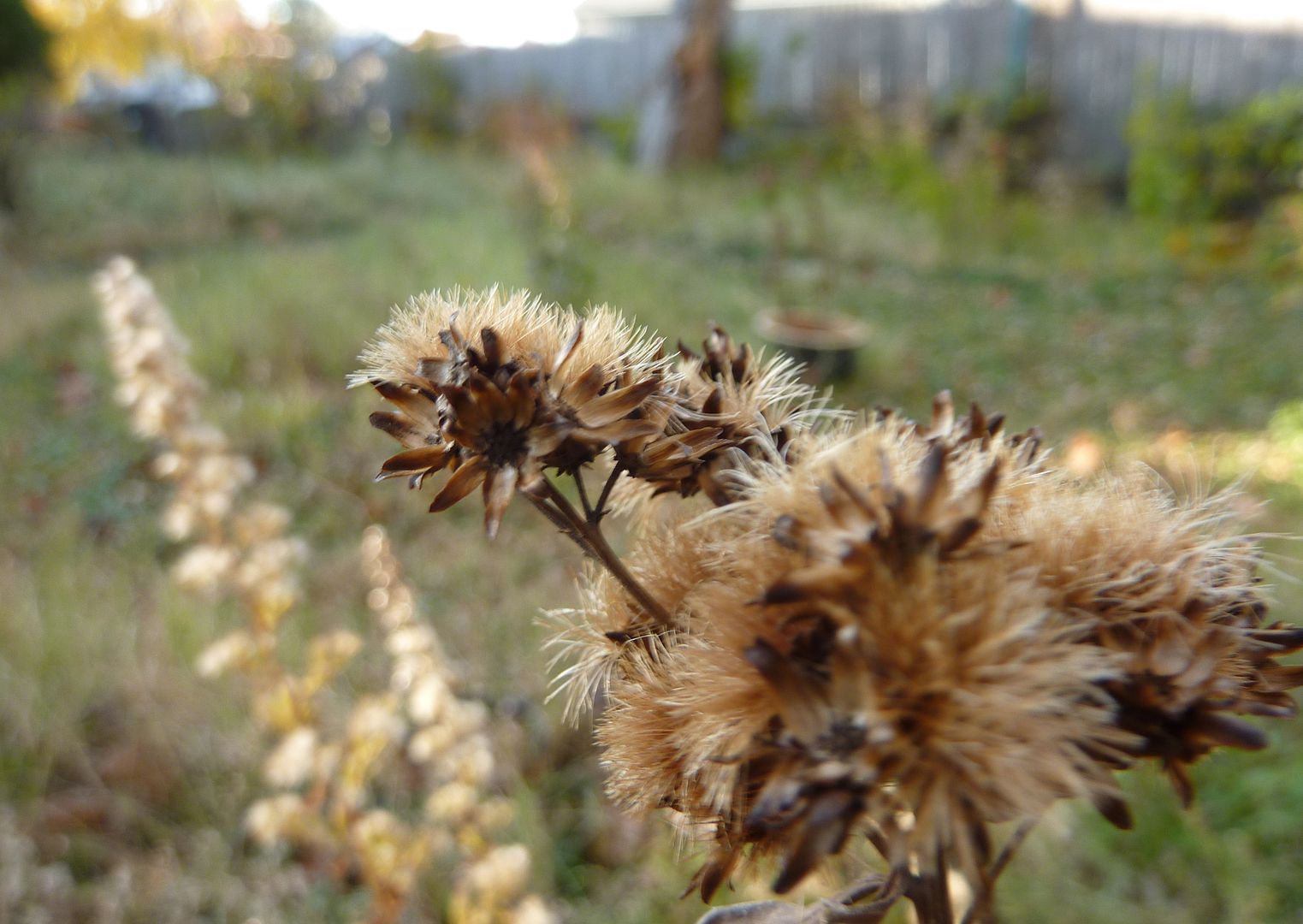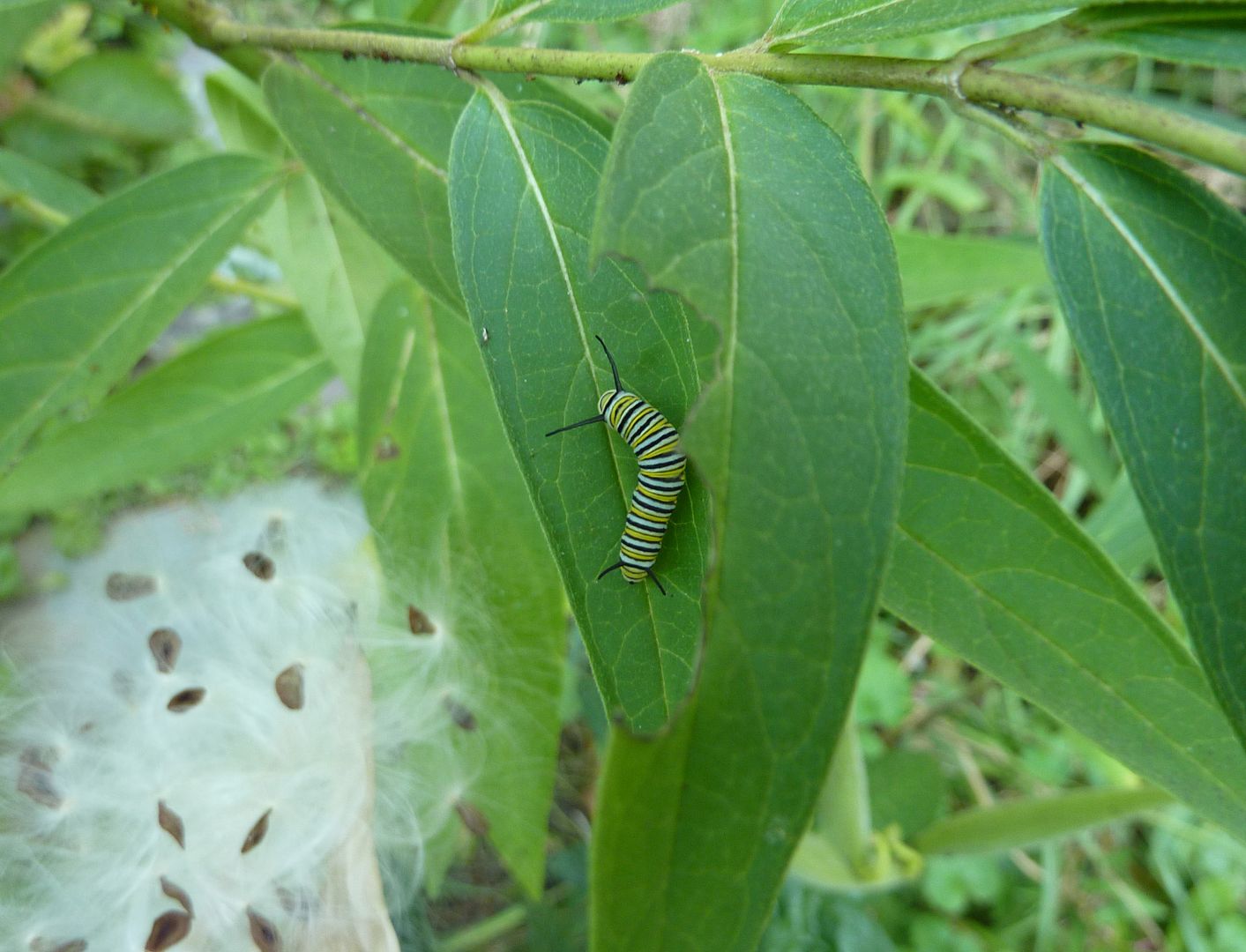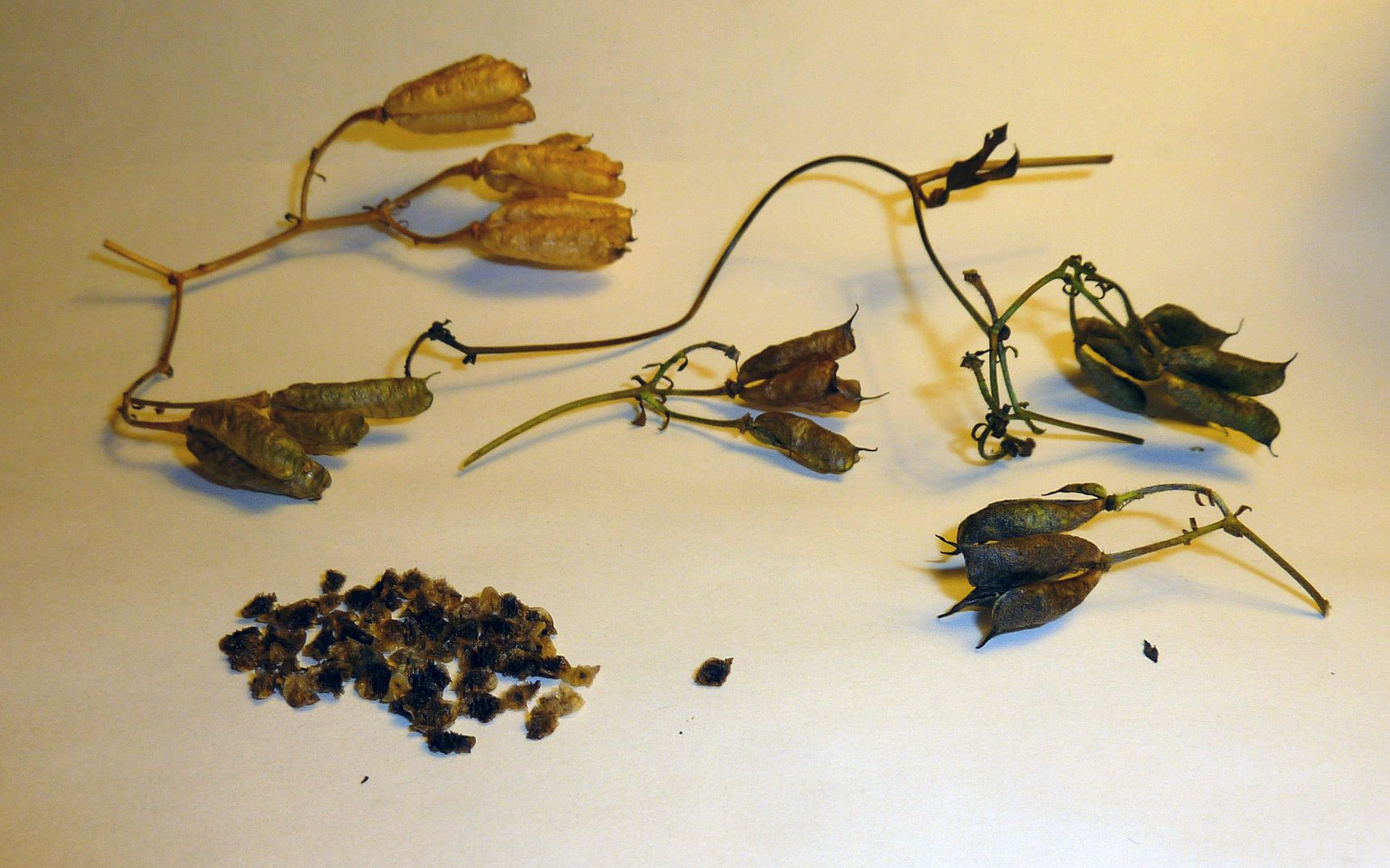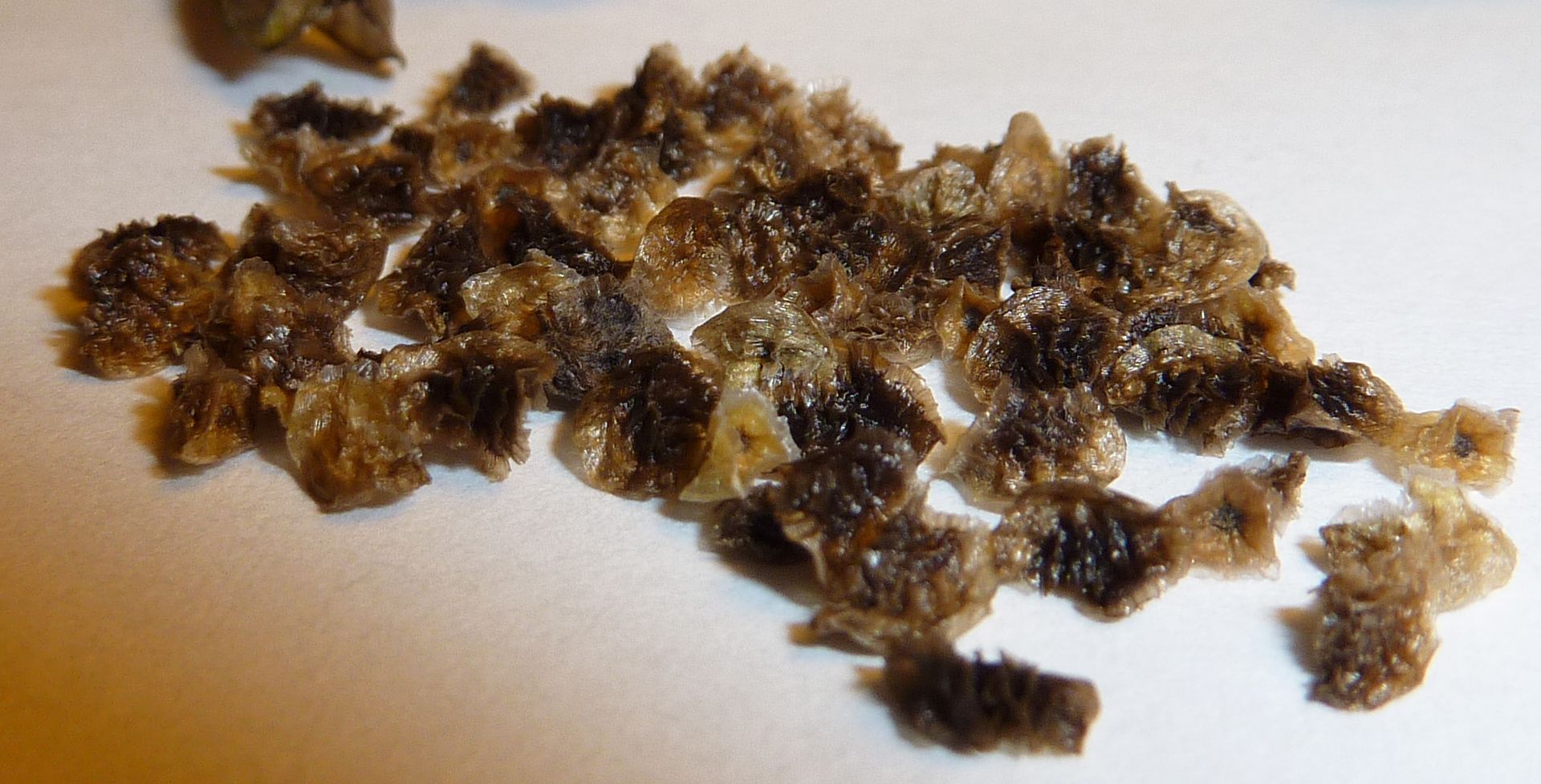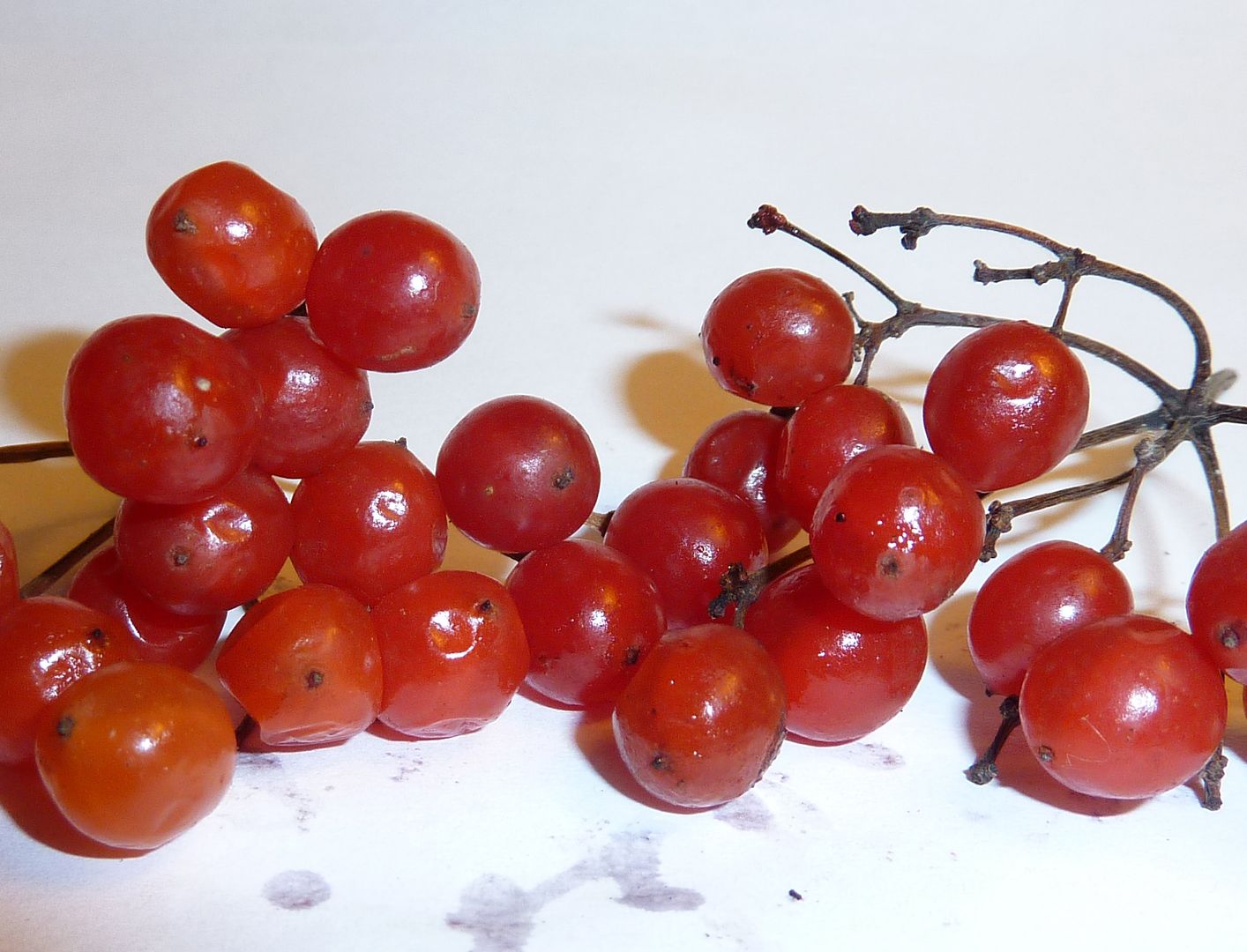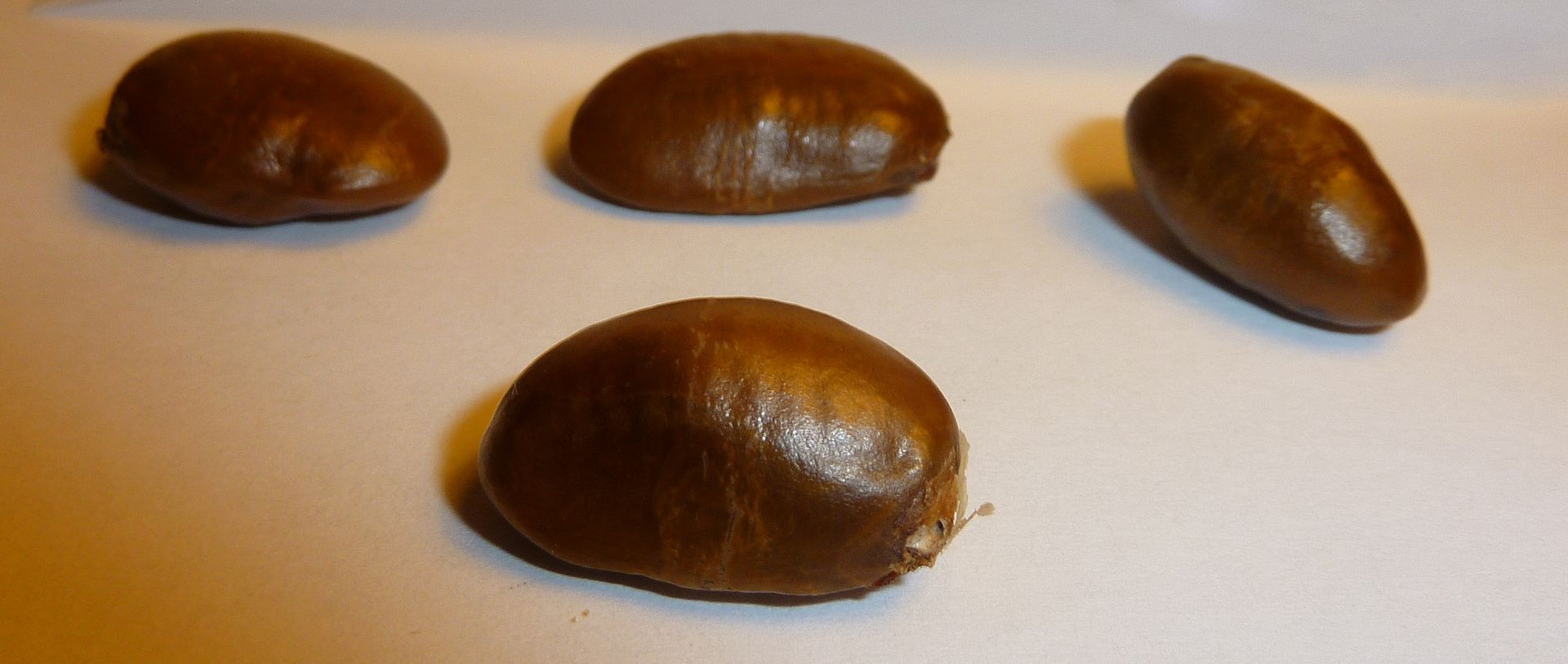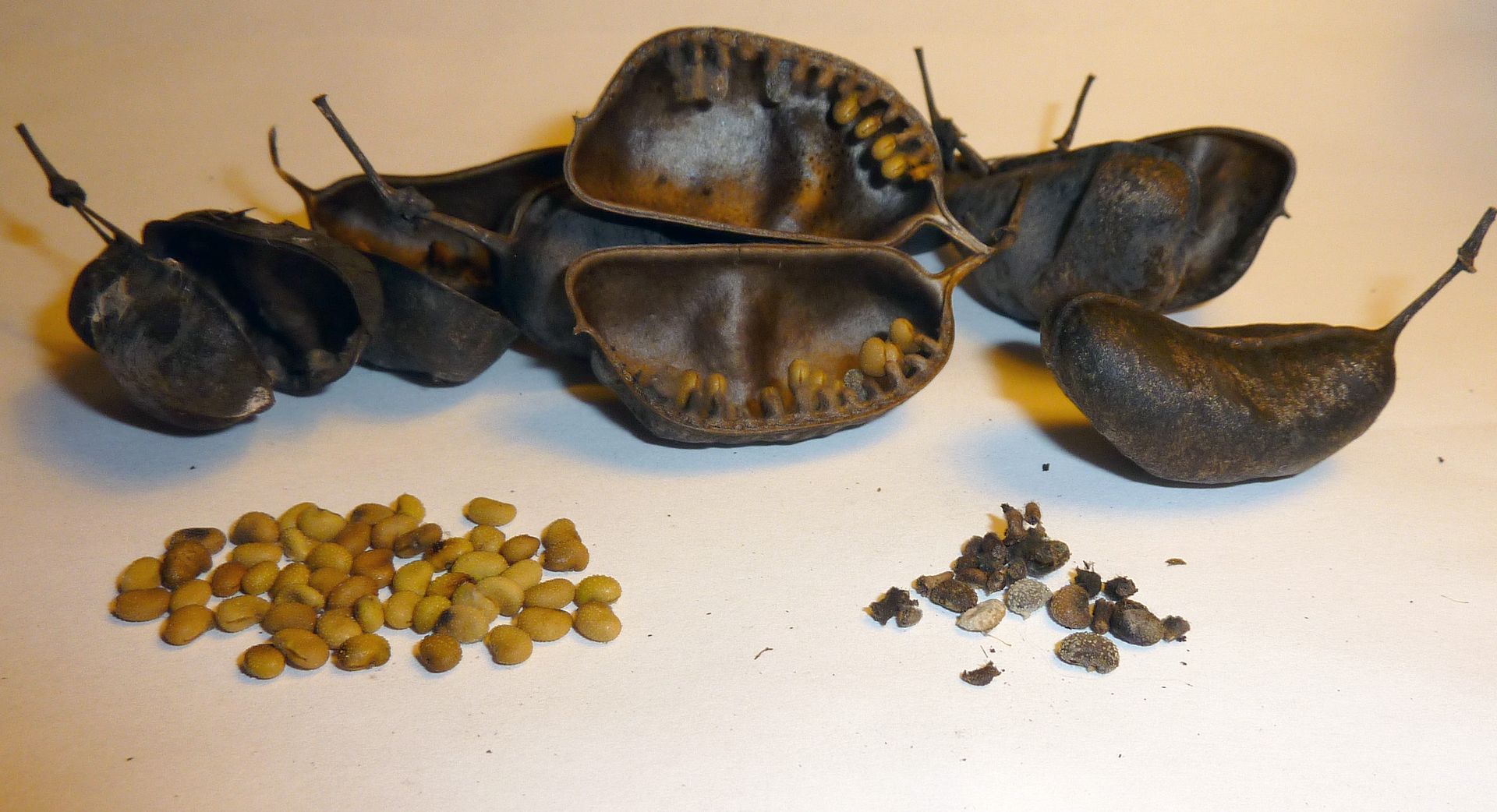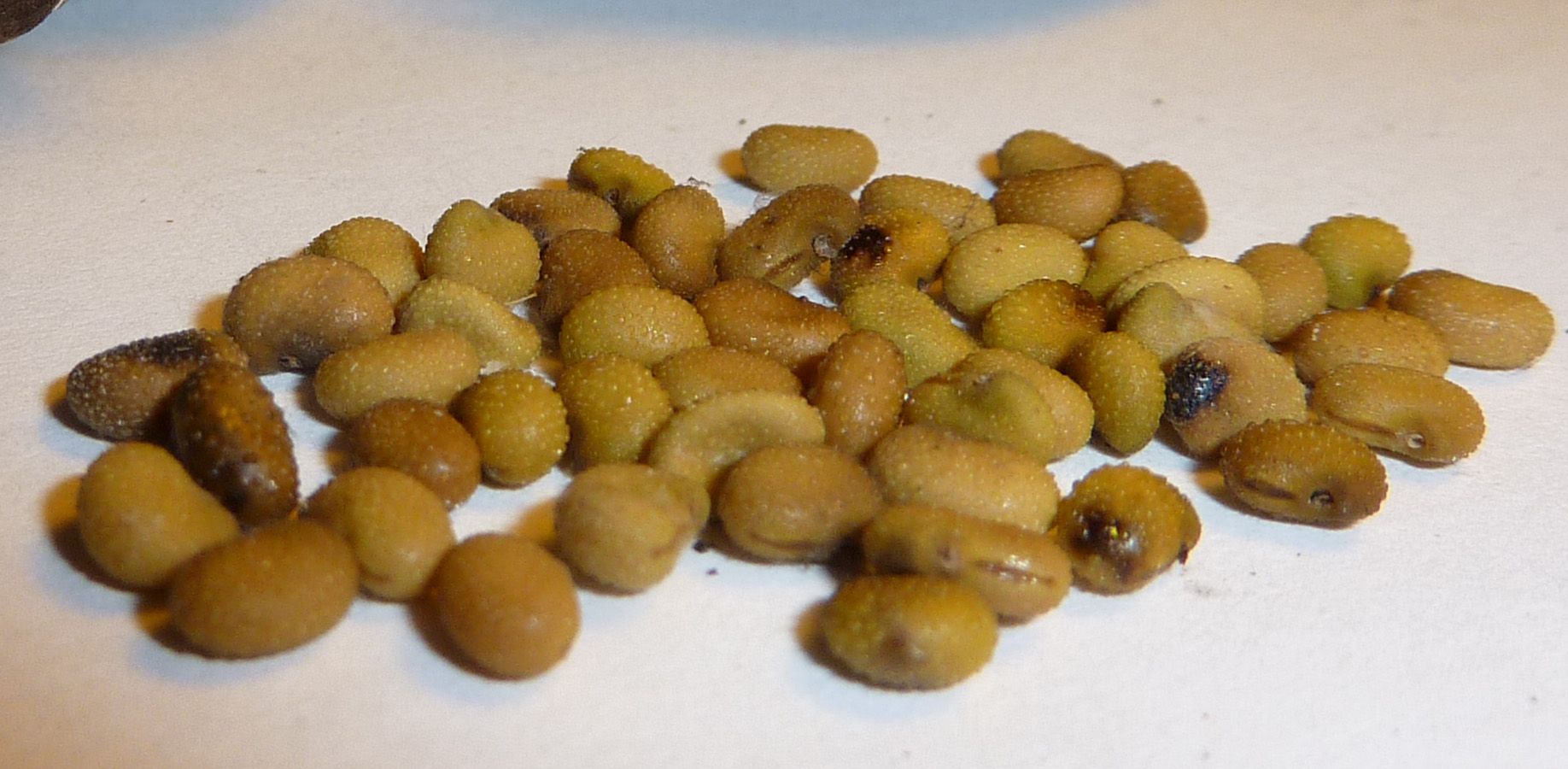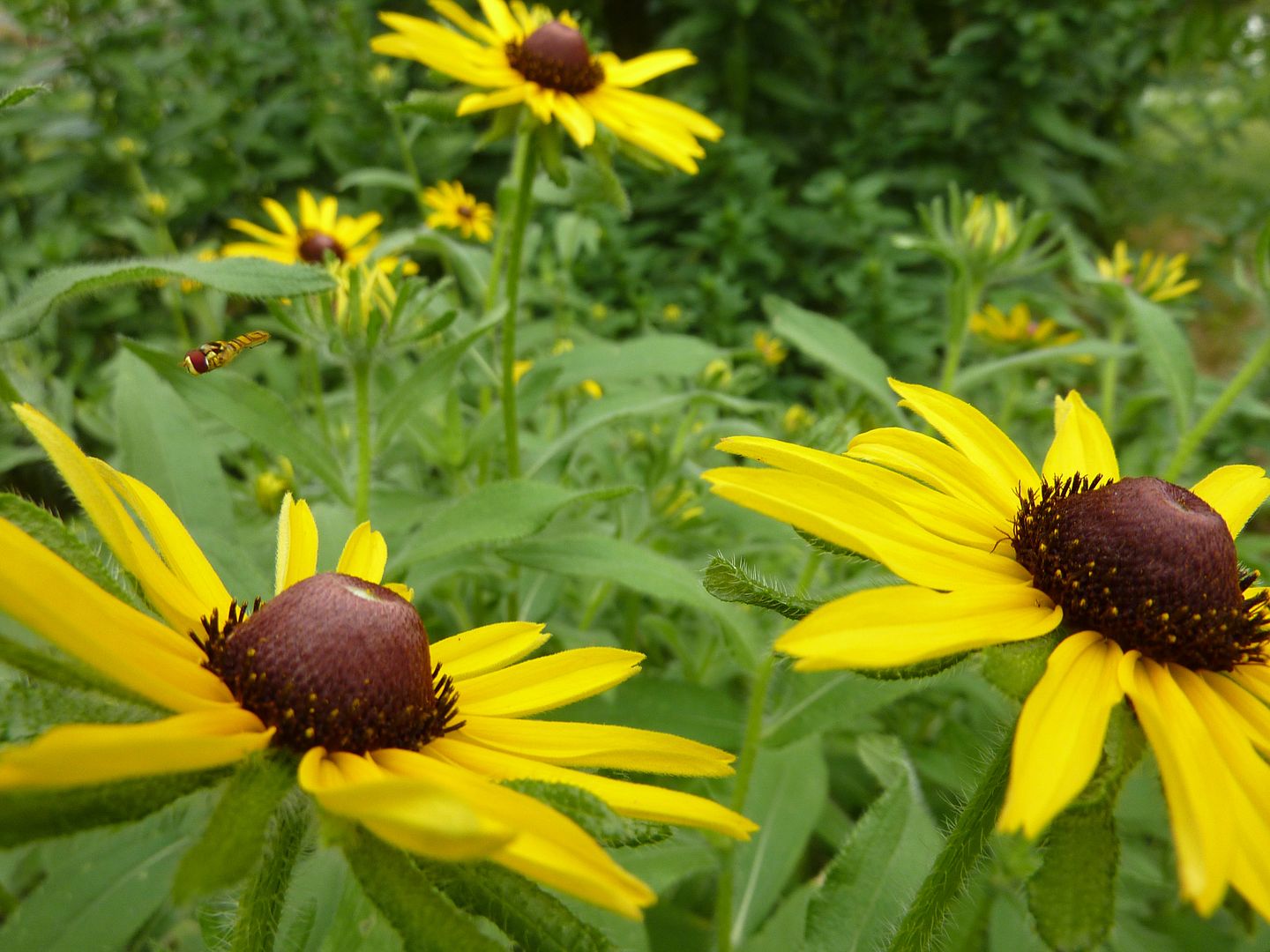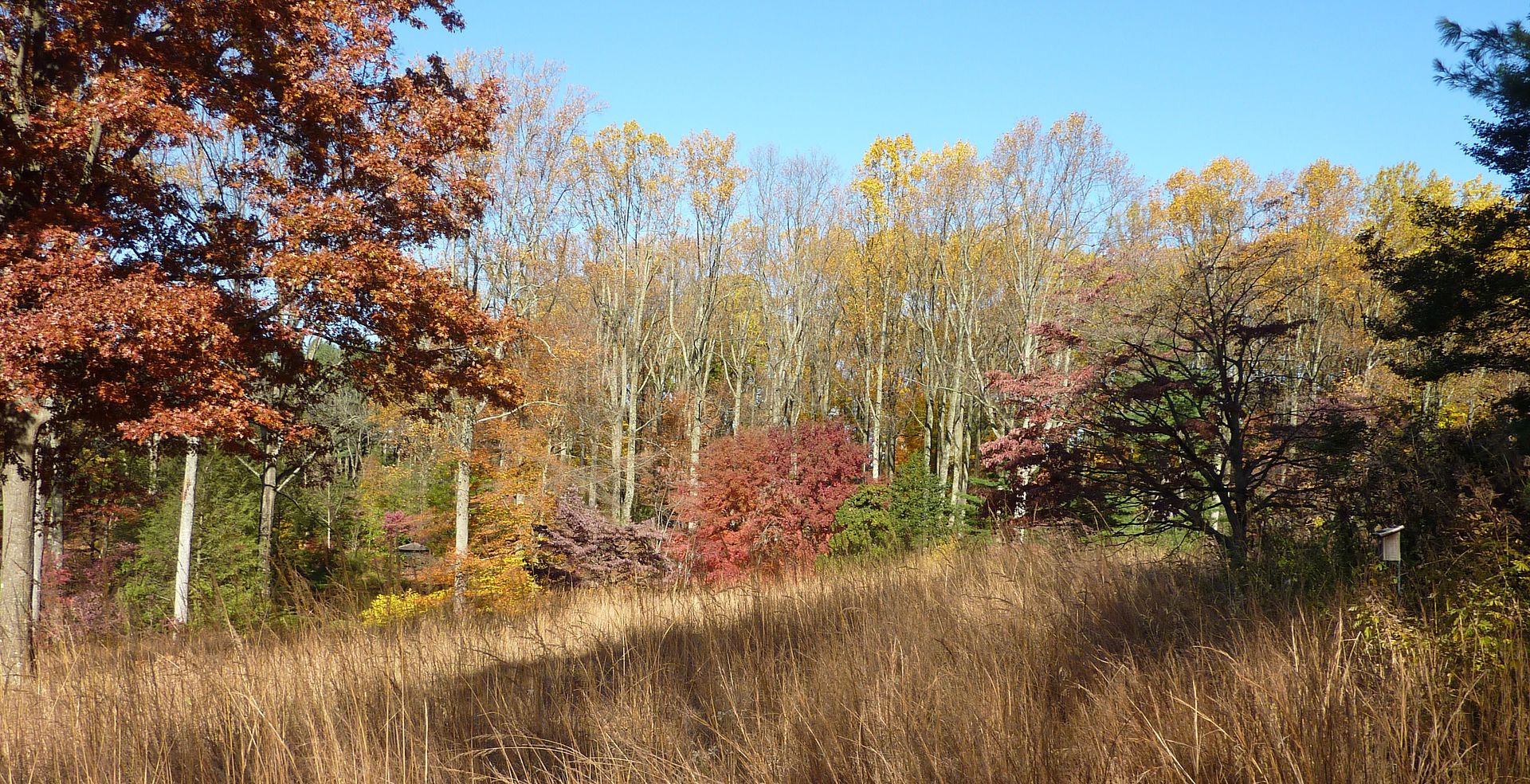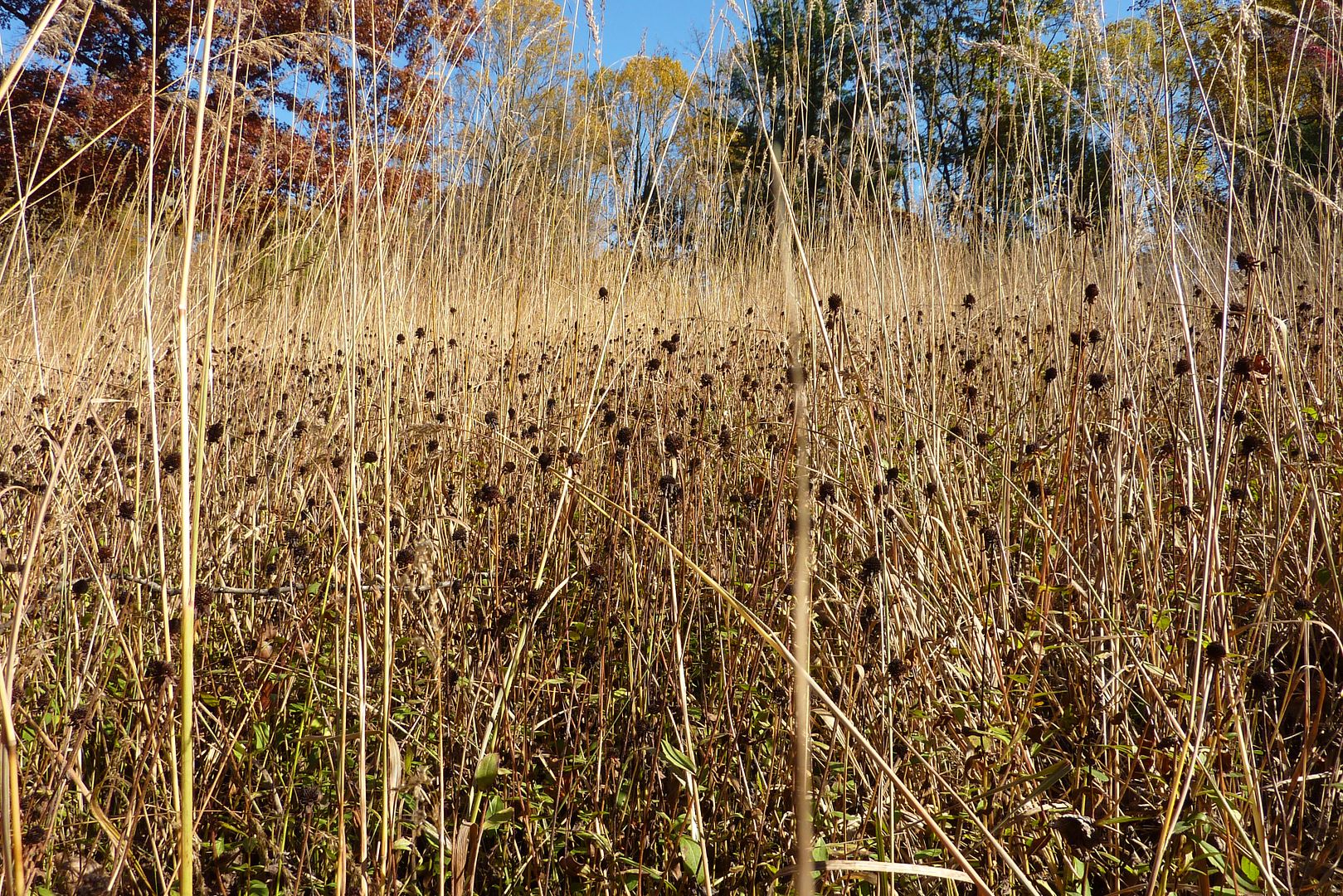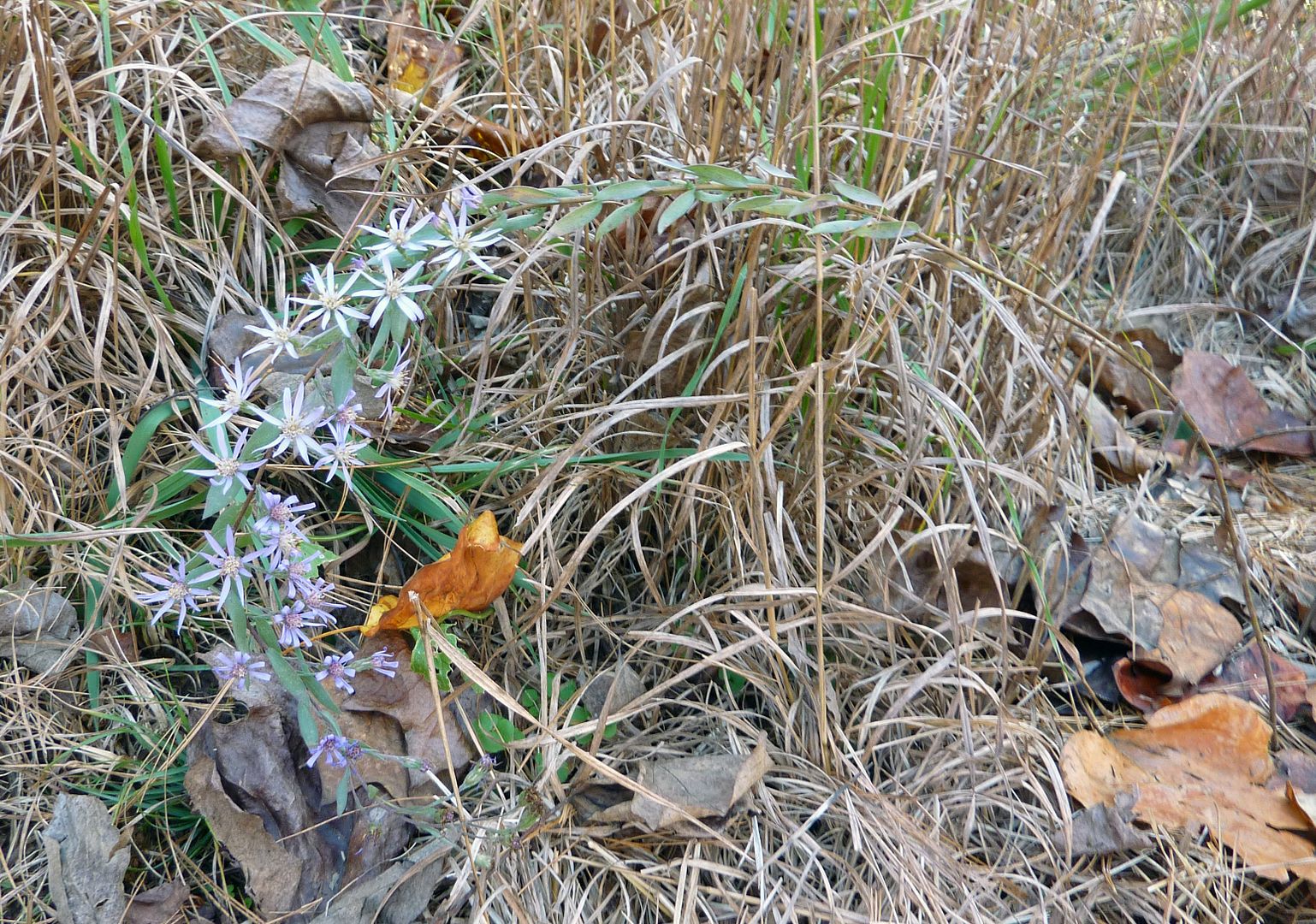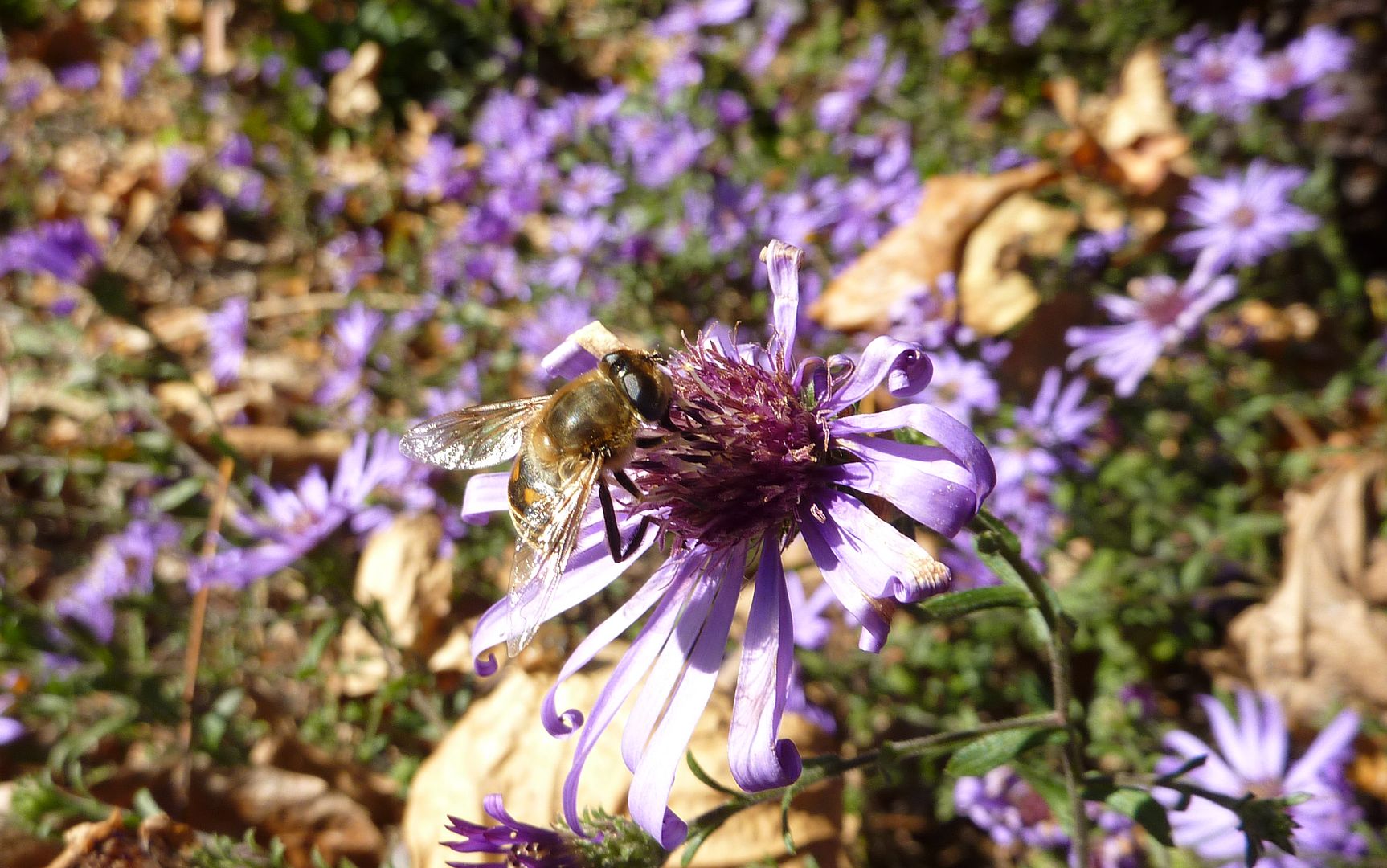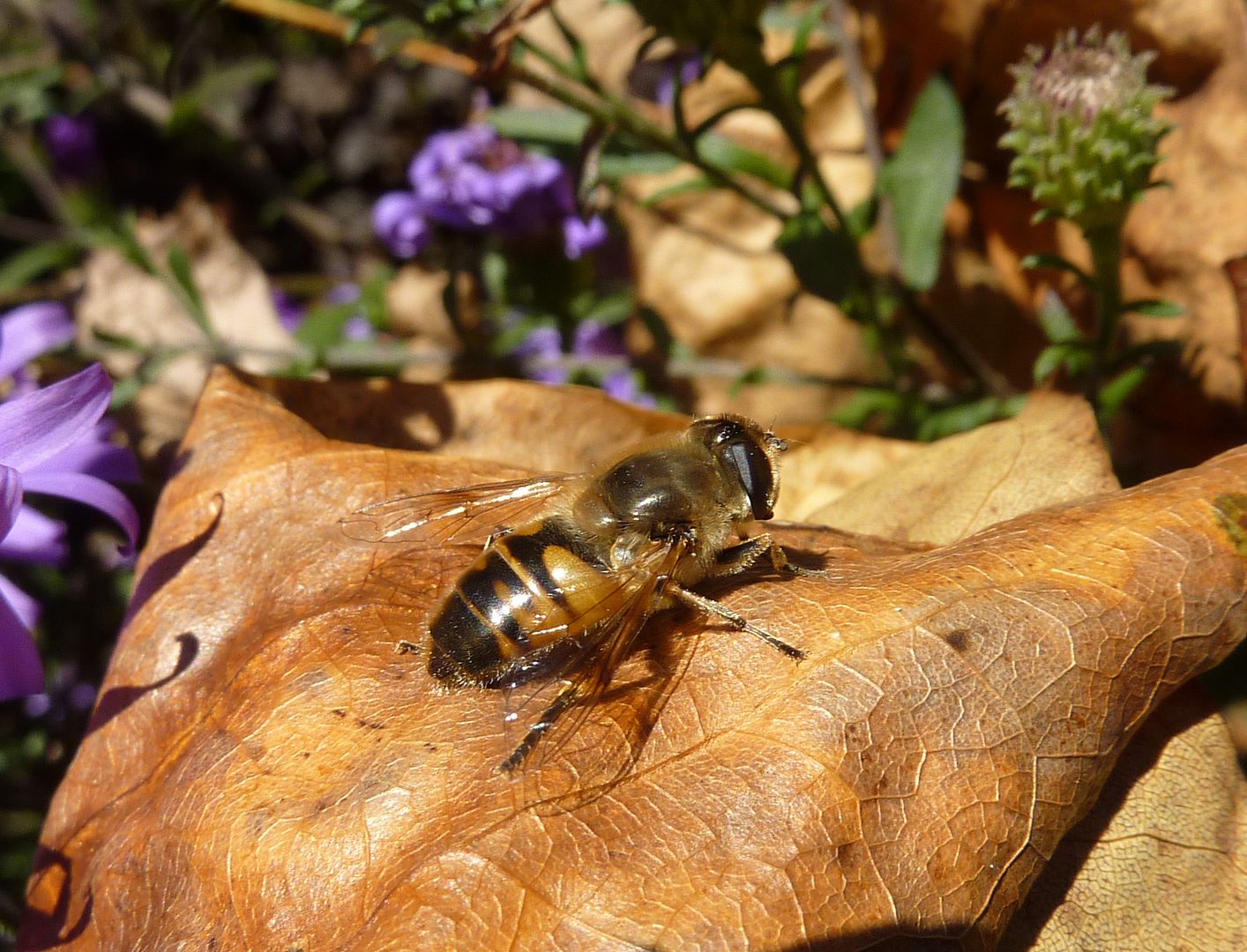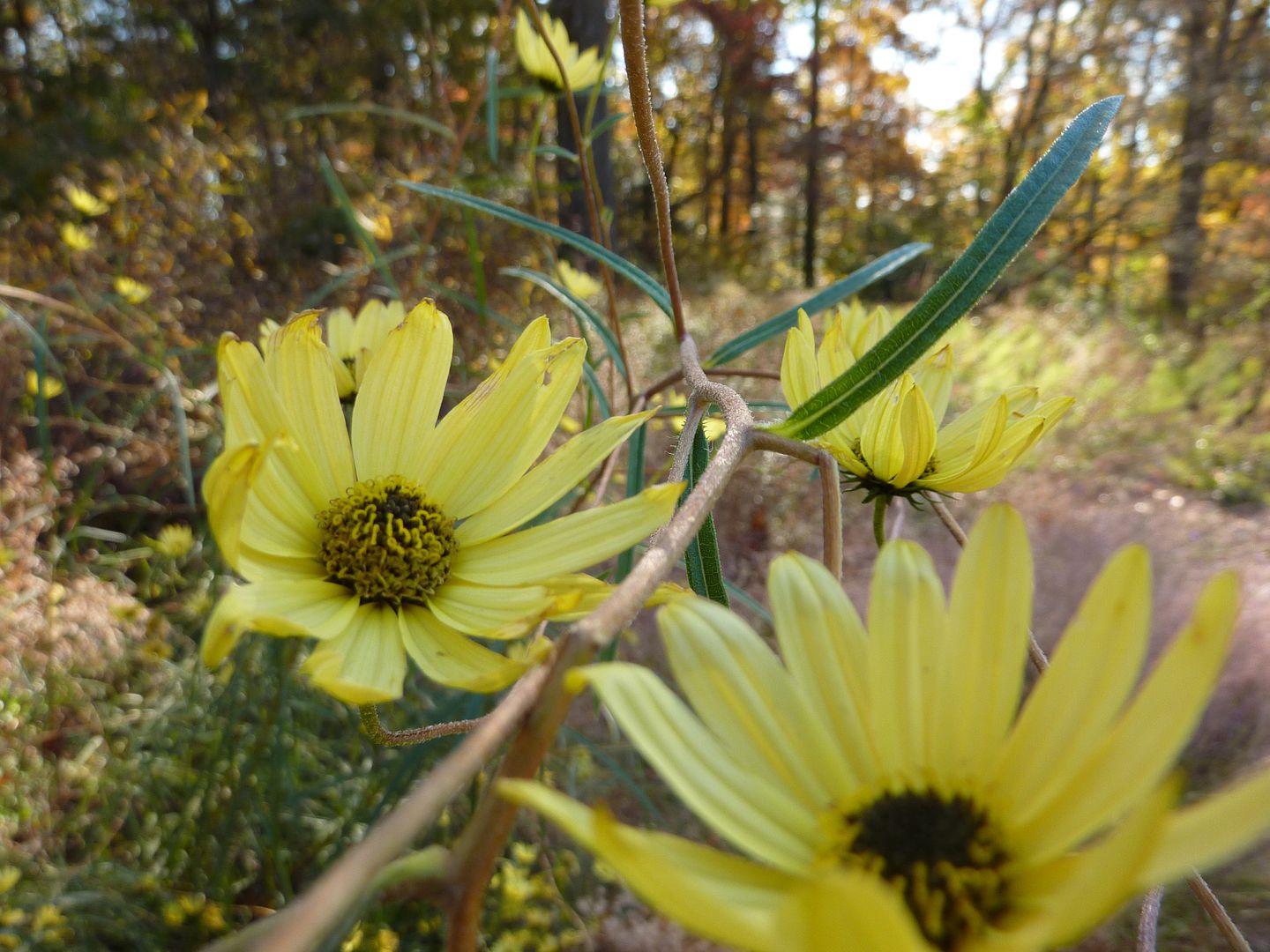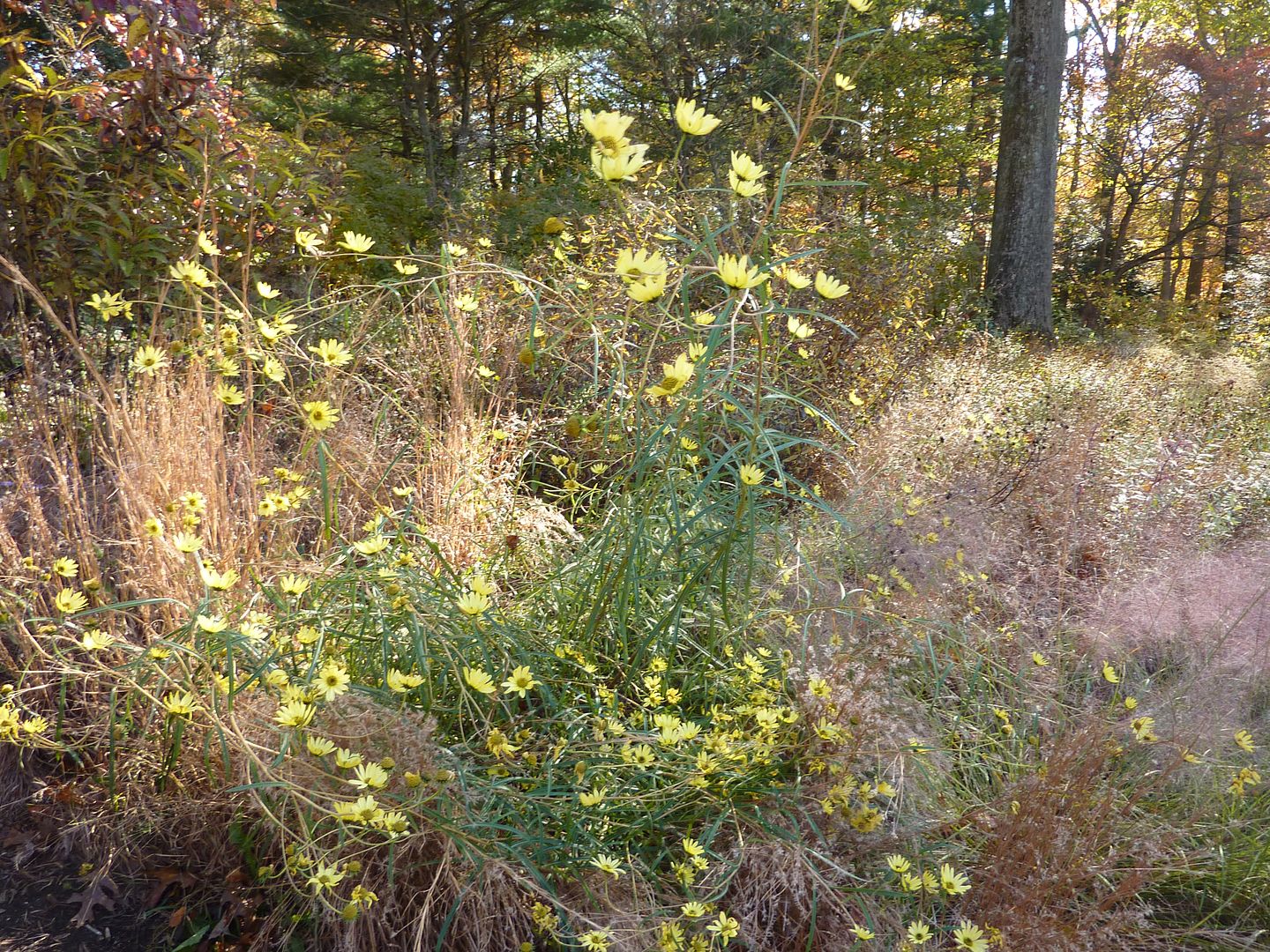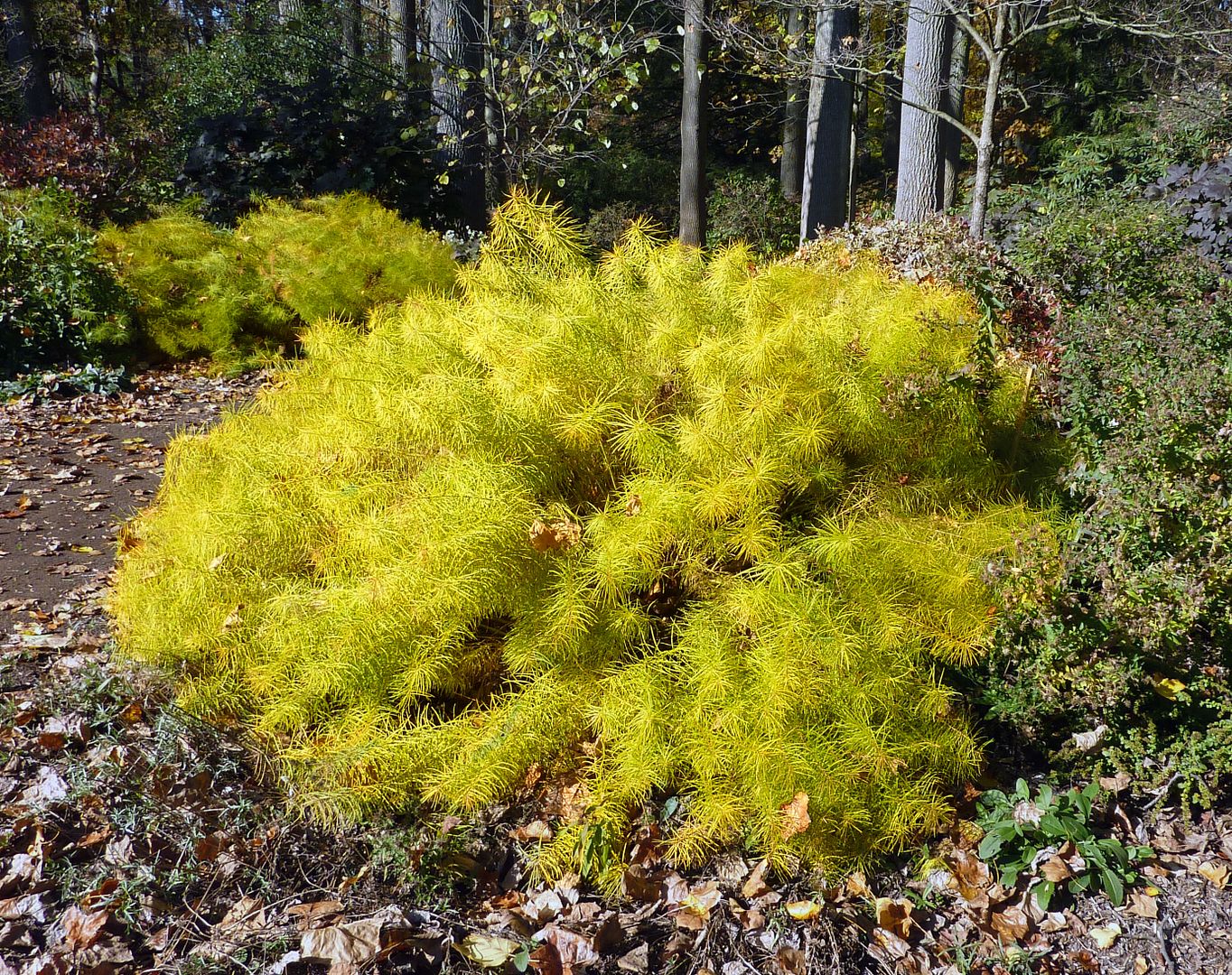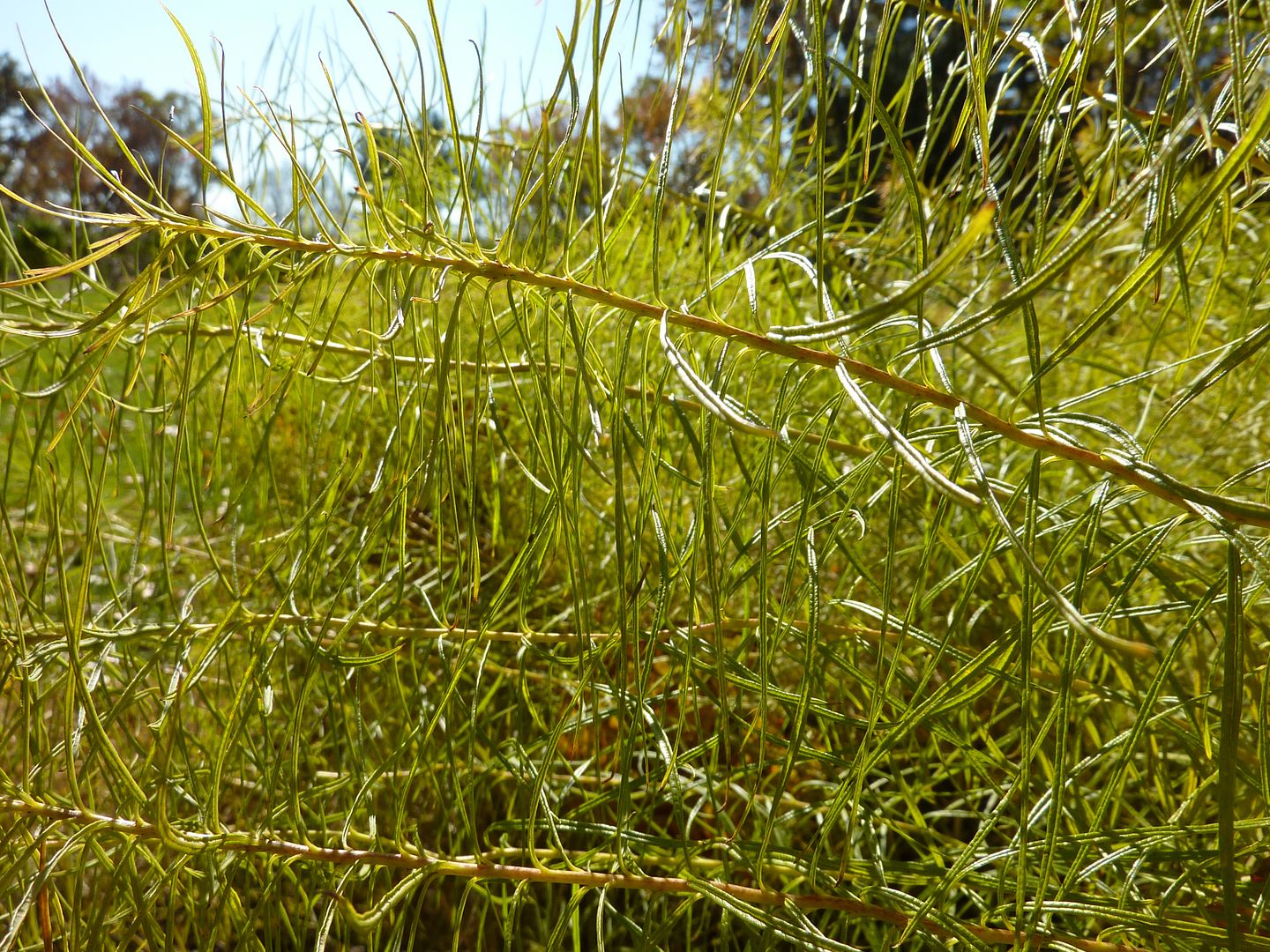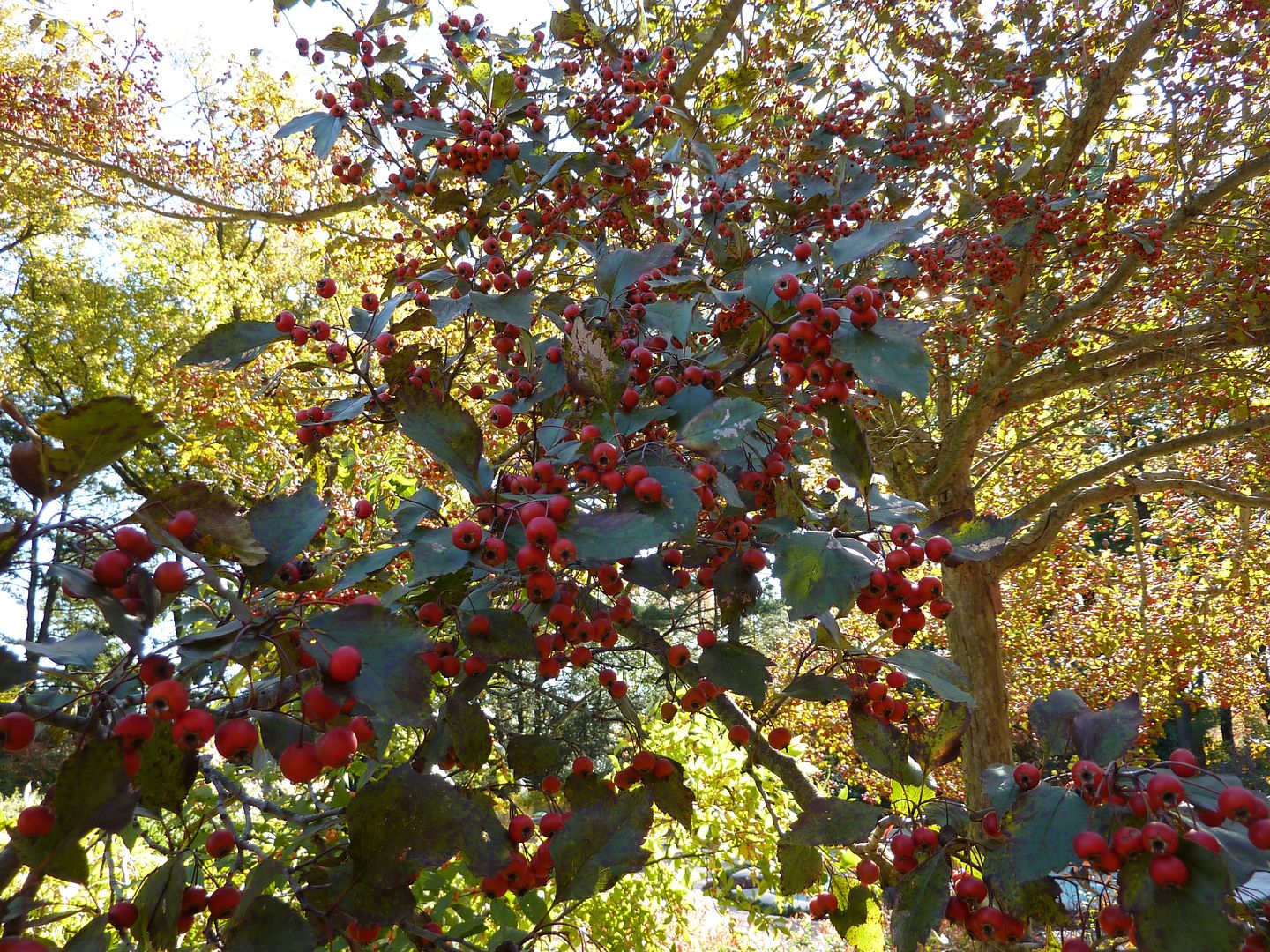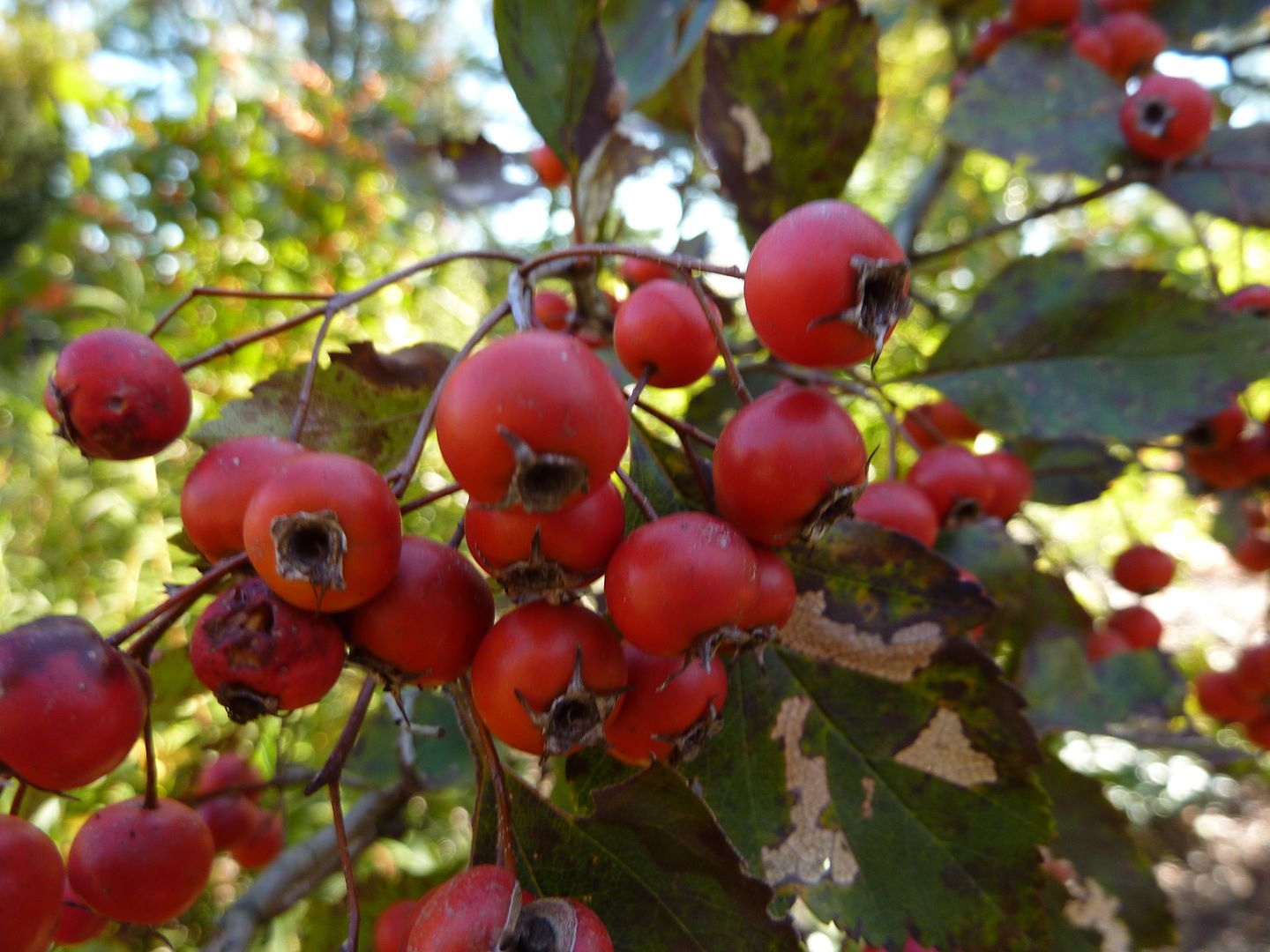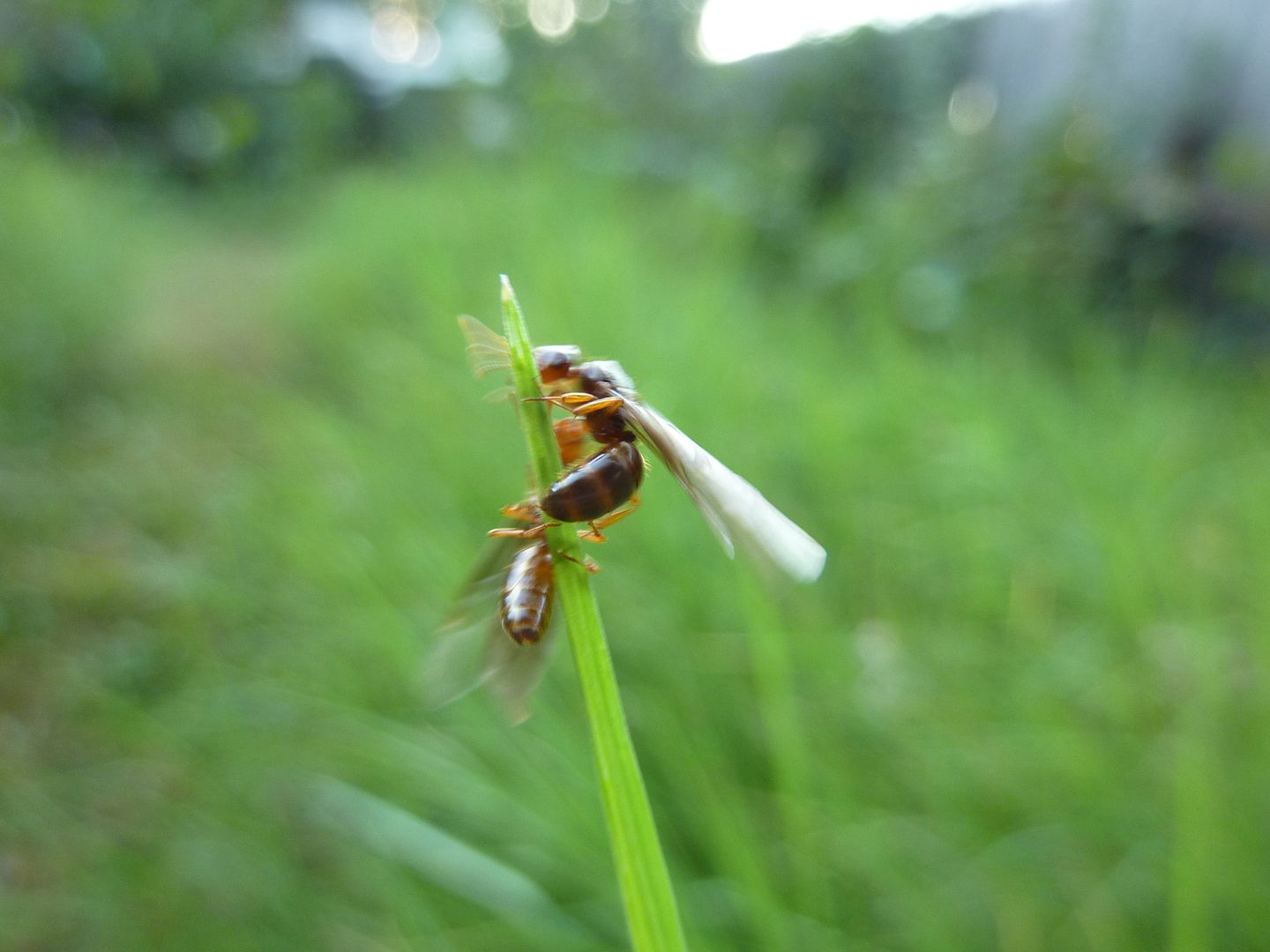Friday, November 25, 2011
A Brief CCD Update
Minus some off comments by the narrator right at the beginning this was well put together. And best of all it doesn't mention Cell Phones.
Here is the full article.
Tuesday, November 22, 2011
Forgive Me Native Plant Gardeners For I Have Sinned
Please forgive me fellow native plant gardeners for I have sinned. In the outdoor gardening section at Lowes Home Improvement I noticed they'd started selling native plants. You can buy Milkweed, Goldenrod, Geraniums, all in nice wonderful 3 gallon pots right alongside the nonnative, ... we'll call them "trash" plants, like Butterfly Bush, and Rose of Sharon. I call these trash plants because I'd never buy most of them. I have been taking advantage of their natives they offer and I praise them for even labeling them as native. Take a step inside though and it's a different story.
Trilliums, Mayapple, Hepatica, Bloodroot, Native Irises, Assorted Ferns, and so on all sold in tiny packets for $2.48. There is little doubt in my mind that they're from questionable sources who probably dig them up from the woods trying to make a quick buck. I did a post about these earlier in the year, about how I'm never going to buy these again.
Look closely thought and you'll see they're all marked down on clearance for .25 cents each. I asked the clerk about this and he said "They're on clearance to make way for holiday stock. They're going to be thrown away if no one buys them."
So I thought why not? I'd hate to let native plants go to waste. And for .25 cents it sounds more like I'm wasting the time of whoever went out into the woods and dug them up.
The most shocking plant they offered was this, Trillium catesbaei. Supposedly it's hardy here but New Jersey is well out of it's native range. The Mt. Cuba Center in Delaware, roughly one hour south of me, has one (just one) they planted as part of a trial garden. They found that it's hardy but not happy. In the 20+ years it's grown there it's only in the past few years that it's finally sent up a second shoot.
As much as I'd like to call these black market plants, I honestly don't know. I don't think anyone knows for sure. All attempts to contact the company to my knowledge have resulted in dead ends. From what I can tell from the packets, the Mayapples seem to be root cuttings. The Rhizomes to everything else look incredibly small. I'm on the fence as to weather they're growing them from seed and selling them ASAP, or only digging up new plants.
Whatever the case I assure you my backyard is better for these plants than the trash can.
(As a side note. When I went to buy these, the poor casher had to change the price on each item individually which took up a lot more time than it should have. I went back a second time and snagged a manager to tell warn them of the coming doom I was about to impose on some casher. They opened a register specifically for me and were able to scan one of each type of plant and change the quantity as well as price. This required a manager's key card to get scanned multiple times and went by so much smoother.)
Trilliums, Mayapple, Hepatica, Bloodroot, Native Irises, Assorted Ferns, and so on all sold in tiny packets for $2.48. There is little doubt in my mind that they're from questionable sources who probably dig them up from the woods trying to make a quick buck. I did a post about these earlier in the year, about how I'm never going to buy these again.
Look closely thought and you'll see they're all marked down on clearance for .25 cents each. I asked the clerk about this and he said "They're on clearance to make way for holiday stock. They're going to be thrown away if no one buys them."
So I thought why not? I'd hate to let native plants go to waste. And for .25 cents it sounds more like I'm wasting the time of whoever went out into the woods and dug them up.
The most shocking plant they offered was this, Trillium catesbaei. Supposedly it's hardy here but New Jersey is well out of it's native range. The Mt. Cuba Center in Delaware, roughly one hour south of me, has one (just one) they planted as part of a trial garden. They found that it's hardy but not happy. In the 20+ years it's grown there it's only in the past few years that it's finally sent up a second shoot.
As much as I'd like to call these black market plants, I honestly don't know. I don't think anyone knows for sure. All attempts to contact the company to my knowledge have resulted in dead ends. From what I can tell from the packets, the Mayapples seem to be root cuttings. The Rhizomes to everything else look incredibly small. I'm on the fence as to weather they're growing them from seed and selling them ASAP, or only digging up new plants.
Whatever the case I assure you my backyard is better for these plants than the trash can.
(As a side note. When I went to buy these, the poor casher had to change the price on each item individually which took up a lot more time than it should have. I went back a second time and snagged a manager to tell warn them of the coming doom I was about to impose on some casher. They opened a register specifically for me and were able to scan one of each type of plant and change the quantity as well as price. This required a manager's key card to get scanned multiple times and went by so much smoother.)
Labels:
Illegal,
native,
Wildflowers
Monday, November 21, 2011
Saturday, November 19, 2011
Starting Native Plants From Seed
Yet again I spontaneously signed up for a class at the Mt. Cuba Center and drove to Delaware at the last minute. This time the class was on starting native plants from seed, a class I wanted to take and thankfully my schedule allowed.
In the past I have been able to get milkweed seeds to germinate simply by keeping them damp. I'd always wondered why though after about two months I'd find them already germinated, and poking out some shoots. Well this class answered my questions and more and I'd like to share what I learned.
Bare in mind, a three hour course is anything but comprehensive. It was very instructive and inspirational enough that I'd like to explore the topic more seriously. Until then, here's the basics of what I learned.
When to Collect
Collecting seeds should be done on a dry day. Seed heads can otherwise be mushy and plants that produce compartments full of seeds don't release them when it's wet. The water gets everywhere and collecting is so much easier when things are dry.
While collecting it's important to sort and label out in the field. Use paper or plastic bag and label everything. Plants that have tiny dots for seeds all look the same.
Seeds that are spread by the wind typically have fluff or down attached to them. Here you can see milkweed seeds in the lower left. There is no need to wait until they've all fluffed out to collect. If the pod has opened it's perfectly fine to pull them all out while they're neat and orderly. This also makes cleaning them easier. A fun fact about milkweed: their seeds will tolerate being burned, but this is not needed for germination. So even if they do puff out you can take a lighter to them in a controlled space and burn off the fluff.
Here we have Wild Monkshood, Aconitum uncinatum. The seed heads form hollow pods with the seeds hanging freely inside. Columbines, Rhododendrons, and many other plants produce seed pods like this. Collecting and sorting is a simple matter of shaking the seeds out.
By sifting seeds on sheets of paper and or shaking them over screens and filters they can eventually be separated by from the more annoying bits of debris.
How to Clean
There are "Dry Seeds" and there are "Wet Seeds." Dry seeds are seeds that have developed without any sort of exterior edible parts to them. I use the word edible loosely as many seeds are themselves edible. Generally Wet seeds differ from dry because they developed inside a fruit or otherwise have external food pockets attached to them such as elaiosome.
Trillium seeds don't need to be removed from their elaiosome packet. However there is always a slight risk of mold feeding growing around it and eventually killing off the seed. Thankfully ants are great about finding such seeds and more than willing to eat the elaiosome food right off.
Highbush Cranberry, Viburnum opulus, is another example of a "wet seed." The berries are edible to humans, and birds find them tasty too. In nature the outer coating of flesh would be digested off after being eaten and eventually leave the seed in a nice clump of fertilizer.
Removing the seed from the flesh is best done by putting all the berries in plastic bags and popping them individually. This frees the fairly large seeds from each berry. From there water can be added and removed and repeated to help rinse away excess material. The whole process can take a day to a week. It's okay to let it ferment but you really want to get that stuff off of the seeds, especially if it starts rotting. Should mold appear you can still remove it and it should be find as long as the mold hasn't totally consumed the seed.
The massive seeds the Pawpaw, Asimina triloba, developed inside of larger fruits. I think they're technically considered wet seed because of this, but seed removal and clean up is as easy as removing those of an apple, pumpkin or watermelon. Clean off and allow to dry before storage.
Checking for Viability
The easiest method is to place the seeds in a bowl of water and maybe shake out all the air bubbles for a few minutes. Room temp is fine, nothing to hot or cold though. Bad seed typically floats, unless you're dealing with a wetland species who's seeds are intended to float. In that case this test is unreliable. For everything else though, bad seeds float because they are hollow. And yes seeds that look good can in fact be bad. It's one of those things you'll never know for sure unless you crack one open or do this test. Good seed typically sinks or is otherwise botany just under the surface.
Here we have seed heads to White False Indigo, Baptisia alba.
Bad seeds are obvious looking. Even here though some of these could potentially be salvaged by removing the mold. Even then though the smaller ones might not be savable.
Good seeds are obvious looking too, but even some of these may have developed hollow.
An issue with the soaking test and member of the pea family is that the seeds need to expand in order to germinate. When checking for viability don't leave these seeds in the water for more than a half hour or so. Maybe don't risk doing it at all even.
For storage leaving them this way is fine. When it comes time to germinate though, this species needs to be soaked in very warm (not scolding) water for 24 hours. They should expand about 3 times bigger and look more pea-like. They can be planted immediately from there and germinate with warmer weather.
How to Store
Moisture is the factors here. Some seed needs to be stored dry or else risk early germination. Others benefit in mortality rate by being kept moist and are triggered to germinate more from periods of hot and cold. For seeds that need to be stored wet, the absolute bare minimum of water is all that's required.
An example the instructor gave was when you take a paper towel and drench it in water, then squeeze out every last drop... that is still too wet! They recommend placing the seeds in a dry paper towel and spraying it twice with a squirt bottle. From there they can be placed in a cheap zip lock bag. Cheap as in nothing fancy, you're not worried about freezer burn, you want the air to circulate and breath somewhat. Leaving the bag open can make them dry out quickly.
Storage can be done at room temperature and in a dark place, however, it's recommended they be kept cool. Once the seed gets the trigger to germinate, some won't hesitate to do so.
How to Germinate
There are many triggers for germination. Just add water being the most common, and most important. Many species require at least a 90 day period of being Cold and Moist as the trigger. For species that don't germinate on cue, being exposed to warmer temps is all that's needed to germinate. More touchy species will require multiple cycles of 90 days of cold, and 90 days of warm to trigger.
Feel free to experiment with methods but also remember to collect enough seeds to experiment with. There are a fair amount of books on the topic of seed germination. Some of them contradict one another. But also some seeds don't care if they're stored in dry or wet conditions. And likewise the need for multiple cycles of hot and cold might not be true for 100% of a population, even if all the seeds came from one plant.
Jewelweed, Impatiens capensis, is an annual who's seeds require multiple hot and cold cycles before they germinate. The result of planting them by seed is they'll reappear once every 3 years. In nature though not every seed gets the memo and a small percent will germinate a year or two later! For a more consistent population in one spot you can put them through periods of hot and cold over the summer and get some to germinate prematurely.
There are a few cases where seeds need Scarification in order to germinate. In nature this would mostly be frozen then thawed, or burned. Gardeners sometimes use acid, sandpaper, or lightly scoring the seed coat to break dormancy.
Once the method of germination has been figured out they recommend placing them in a plastic bag with equal parts medium to seeds. So a light airy seed starting mix is what's required. Mix to combine, then give them just a squirt of water. When they germinate they can carefully be moved to a flat. The idea of adding the soil is to maximize moisture contact.
At this point a small minority of seeds demand sunlight in order to germinate. Such is the case for Black Eyed Susans, Rudbecia fulgida. In nature, If there's too much organic matter laying around, their seeds won't germinate. Instead they go dormant and wait for sunlight to finally reach them. Plants like this are known to appear in great numbers after disturbances such as fires, or trees falling over in the woods. Species like this tend to be annuals, biannual, or short lived perennials at most. Their populations booms until once again the amount of organic matter prevents their spread. Ungerminated seeds lay dormant in the seed bank below the leaves.
You can skip the soil in bag method and just plant seeds directly into flats. When you do, make sure soil is up to the rim of each chamber. Lightly water before you plant the seeds. NOTE: it is physically imposable for a plant to absorb more than it's mass in water in one day. Watering with an eye dropper is perfectly fine! Adding too much water is the easiest way to kill all of your plants. Over watering causes the soil in each compartment to form a dense layer on top which is ideal for mold and fungi to cling onto and eventually nibble the narrow shoot of each seedling. Also don't pat the soil down! You want nice even airflow but some mild tampering is okay.
Seeds that demand sunlight to germinate can be sprinkled on the surface. There are special tools sold for this purpose and some mail order places even provide them with orders. Otherwise the general rule is to plant each seed 3 to 4 times deep as the seed is wide.
Heating pads and seed germinating products are also okay to use. In the case of heating pads though they really aren't needed after germination. Especially in a green house setting you can end up cooking your plants. They do benefit some plants such as tomatoes though which don't grow until the soil is over 60F. As your plants grow bigger and bigger their water demands will be greater and greater.
Mold Gnats will be a problem. These are those annoying flies that always seem to show up around potted plants. They are slow moving compared to the typical house fly and fairly easy to swat. The trouble is by the time you see the adults they've more than likely laid eggs for the next generation. These are typically an indoor problem and quickly disperse in an opened green house or outdoor setting. Pesticides can kill them easy but are also harsh on young seedlings, so don't use them! Nematodes are an easy solution but have to be reapplied every few weeks.
In the past I have been able to get milkweed seeds to germinate simply by keeping them damp. I'd always wondered why though after about two months I'd find them already germinated, and poking out some shoots. Well this class answered my questions and more and I'd like to share what I learned.
Bare in mind, a three hour course is anything but comprehensive. It was very instructive and inspirational enough that I'd like to explore the topic more seriously. Until then, here's the basics of what I learned.
When to Collect
Collecting seeds should be done on a dry day. Seed heads can otherwise be mushy and plants that produce compartments full of seeds don't release them when it's wet. The water gets everywhere and collecting is so much easier when things are dry.
While collecting it's important to sort and label out in the field. Use paper or plastic bag and label everything. Plants that have tiny dots for seeds all look the same.
Seeds that are spread by the wind typically have fluff or down attached to them. Here you can see milkweed seeds in the lower left. There is no need to wait until they've all fluffed out to collect. If the pod has opened it's perfectly fine to pull them all out while they're neat and orderly. This also makes cleaning them easier. A fun fact about milkweed: their seeds will tolerate being burned, but this is not needed for germination. So even if they do puff out you can take a lighter to them in a controlled space and burn off the fluff.
Here we have Wild Monkshood, Aconitum uncinatum. The seed heads form hollow pods with the seeds hanging freely inside. Columbines, Rhododendrons, and many other plants produce seed pods like this. Collecting and sorting is a simple matter of shaking the seeds out.
By sifting seeds on sheets of paper and or shaking them over screens and filters they can eventually be separated by from the more annoying bits of debris.
How to Clean
There are "Dry Seeds" and there are "Wet Seeds." Dry seeds are seeds that have developed without any sort of exterior edible parts to them. I use the word edible loosely as many seeds are themselves edible. Generally Wet seeds differ from dry because they developed inside a fruit or otherwise have external food pockets attached to them such as elaiosome.
Trillium seeds don't need to be removed from their elaiosome packet. However there is always a slight risk of mold feeding growing around it and eventually killing off the seed. Thankfully ants are great about finding such seeds and more than willing to eat the elaiosome food right off.
Highbush Cranberry, Viburnum opulus, is another example of a "wet seed." The berries are edible to humans, and birds find them tasty too. In nature the outer coating of flesh would be digested off after being eaten and eventually leave the seed in a nice clump of fertilizer.
Removing the seed from the flesh is best done by putting all the berries in plastic bags and popping them individually. This frees the fairly large seeds from each berry. From there water can be added and removed and repeated to help rinse away excess material. The whole process can take a day to a week. It's okay to let it ferment but you really want to get that stuff off of the seeds, especially if it starts rotting. Should mold appear you can still remove it and it should be find as long as the mold hasn't totally consumed the seed.
The massive seeds the Pawpaw, Asimina triloba, developed inside of larger fruits. I think they're technically considered wet seed because of this, but seed removal and clean up is as easy as removing those of an apple, pumpkin or watermelon. Clean off and allow to dry before storage.
Checking for Viability
The easiest method is to place the seeds in a bowl of water and maybe shake out all the air bubbles for a few minutes. Room temp is fine, nothing to hot or cold though. Bad seed typically floats, unless you're dealing with a wetland species who's seeds are intended to float. In that case this test is unreliable. For everything else though, bad seeds float because they are hollow. And yes seeds that look good can in fact be bad. It's one of those things you'll never know for sure unless you crack one open or do this test. Good seed typically sinks or is otherwise botany just under the surface.
Here we have seed heads to White False Indigo, Baptisia alba.
Bad seeds are obvious looking. Even here though some of these could potentially be salvaged by removing the mold. Even then though the smaller ones might not be savable.
Good seeds are obvious looking too, but even some of these may have developed hollow.
An issue with the soaking test and member of the pea family is that the seeds need to expand in order to germinate. When checking for viability don't leave these seeds in the water for more than a half hour or so. Maybe don't risk doing it at all even.
For storage leaving them this way is fine. When it comes time to germinate though, this species needs to be soaked in very warm (not scolding) water for 24 hours. They should expand about 3 times bigger and look more pea-like. They can be planted immediately from there and germinate with warmer weather.
How to Store
Moisture is the factors here. Some seed needs to be stored dry or else risk early germination. Others benefit in mortality rate by being kept moist and are triggered to germinate more from periods of hot and cold. For seeds that need to be stored wet, the absolute bare minimum of water is all that's required.
An example the instructor gave was when you take a paper towel and drench it in water, then squeeze out every last drop... that is still too wet! They recommend placing the seeds in a dry paper towel and spraying it twice with a squirt bottle. From there they can be placed in a cheap zip lock bag. Cheap as in nothing fancy, you're not worried about freezer burn, you want the air to circulate and breath somewhat. Leaving the bag open can make them dry out quickly.
Storage can be done at room temperature and in a dark place, however, it's recommended they be kept cool. Once the seed gets the trigger to germinate, some won't hesitate to do so.
How to Germinate
There are many triggers for germination. Just add water being the most common, and most important. Many species require at least a 90 day period of being Cold and Moist as the trigger. For species that don't germinate on cue, being exposed to warmer temps is all that's needed to germinate. More touchy species will require multiple cycles of 90 days of cold, and 90 days of warm to trigger.
Feel free to experiment with methods but also remember to collect enough seeds to experiment with. There are a fair amount of books on the topic of seed germination. Some of them contradict one another. But also some seeds don't care if they're stored in dry or wet conditions. And likewise the need for multiple cycles of hot and cold might not be true for 100% of a population, even if all the seeds came from one plant.
Jewelweed, Impatiens capensis, is an annual who's seeds require multiple hot and cold cycles before they germinate. The result of planting them by seed is they'll reappear once every 3 years. In nature though not every seed gets the memo and a small percent will germinate a year or two later! For a more consistent population in one spot you can put them through periods of hot and cold over the summer and get some to germinate prematurely.
There are a few cases where seeds need Scarification in order to germinate. In nature this would mostly be frozen then thawed, or burned. Gardeners sometimes use acid, sandpaper, or lightly scoring the seed coat to break dormancy.
Once the method of germination has been figured out they recommend placing them in a plastic bag with equal parts medium to seeds. So a light airy seed starting mix is what's required. Mix to combine, then give them just a squirt of water. When they germinate they can carefully be moved to a flat. The idea of adding the soil is to maximize moisture contact.
At this point a small minority of seeds demand sunlight in order to germinate. Such is the case for Black Eyed Susans, Rudbecia fulgida. In nature, If there's too much organic matter laying around, their seeds won't germinate. Instead they go dormant and wait for sunlight to finally reach them. Plants like this are known to appear in great numbers after disturbances such as fires, or trees falling over in the woods. Species like this tend to be annuals, biannual, or short lived perennials at most. Their populations booms until once again the amount of organic matter prevents their spread. Ungerminated seeds lay dormant in the seed bank below the leaves.
You can skip the soil in bag method and just plant seeds directly into flats. When you do, make sure soil is up to the rim of each chamber. Lightly water before you plant the seeds. NOTE: it is physically imposable for a plant to absorb more than it's mass in water in one day. Watering with an eye dropper is perfectly fine! Adding too much water is the easiest way to kill all of your plants. Over watering causes the soil in each compartment to form a dense layer on top which is ideal for mold and fungi to cling onto and eventually nibble the narrow shoot of each seedling. Also don't pat the soil down! You want nice even airflow but some mild tampering is okay.
Seeds that demand sunlight to germinate can be sprinkled on the surface. There are special tools sold for this purpose and some mail order places even provide them with orders. Otherwise the general rule is to plant each seed 3 to 4 times deep as the seed is wide.
Heating pads and seed germinating products are also okay to use. In the case of heating pads though they really aren't needed after germination. Especially in a green house setting you can end up cooking your plants. They do benefit some plants such as tomatoes though which don't grow until the soil is over 60F. As your plants grow bigger and bigger their water demands will be greater and greater.
Mold Gnats will be a problem. These are those annoying flies that always seem to show up around potted plants. They are slow moving compared to the typical house fly and fairly easy to swat. The trouble is by the time you see the adults they've more than likely laid eggs for the next generation. These are typically an indoor problem and quickly disperse in an opened green house or outdoor setting. Pesticides can kill them easy but are also harsh on young seedlings, so don't use them! Nematodes are an easy solution but have to be reapplied every few weeks.
Thursday, November 17, 2011
Rambunctious Garden: Things I Disagree With
In my review of "Rambunctious Garden" by Emma Marris I got a comment by user Skr and I've decided to give this more attention as my reply started fleshing out into a small book. Overall I feel like everyone is enjoying this book but me so maybe I'm just stubborn. I don't mean this to single anyone out but I feel it's worthy of a topic in itself.
First off to Skr only: If you have a blog, or website (Flickr album?) you'd like me to list I'd be more than happy to include it. Also if you find you have a reply to this that turns into a short story of it's own I'd be happy to post it as a guest post. Should either be the case e-mail me at MrILoveTheAnts @ yahoo.com
Pound per pound insects have twice as much protein in them as other animal meats. They are the number one food item fed to baby birds, and are a favorite among reptiles, amphibians, fish, and so on. If you don't have an abundance of insects, it can send ripples through the food web.
I like to compare this to eating at the mall food court. Here we have an assortment of food cuisines to pick from but the average person doesn't eat them all. Personally I can't stomach most Mexican food, I'm afraid to try anything Asian, and I've never given Indian food any thought. Insects who typically only have a few weeks to get it right before they die have to lay their eggs in the right spot, or on the right plant, and they have to eat the correct diet for the simple fact that they can't eat anything else. In most cases this is only a hand full of plants, that are almost always in genera that they've closely evolved with.
An example Emma gives to support the benefit of nonnatives is Rodrigues island, found about 350 miles east of Mauritius island off the coast of Madagascar. It is in her book on page 97-98.
View Larger Map
This massive island was supposidly logged, and then supposidly replanted? To be perfectly honest I don't see how either could be done effectively. We're not talking about just an island so much as a small city. She might as well be talking about Hawaii again. Had her book included pictures it might have been apparent to everyone that she was talking about an island inhabited by people.
There are paved roads, houses, air ports, farms, mountains, what look to be beach side resorts. None of this was mentioned in her book. So this is no longer a simple matter of adding and subtracting trees. How many of these people have bird feeders? How many put out bird houses? When she talks about replanting does she mean the bustling agricultural farms scattered all over the island? Are these nonnative trees simply common landscaping plants I can find at my local nursery? She might as well be talking about where I live in New Jersey. We have fragmented forests of native trees, and all the clearings are landscaped with mostly nonnative plants. I even doubt the people who planted them put any thought into their origin.
Wikipedia seems to think the bird issue she mentions was due to over hunting and overgrazing by livestock, not so much logging. Regardless, the issue was habitat lose and we don't regain that with alien species. Emma doesn't seem to mention anything about their conservation efforts to maintain some of their remaining threatened species. Or the captive breeding program for her bat species she mentions. They were eating the fruit to some of the nonnatives such as rose apple, which these birds and bats were likely helping to spread around the island. She just assumes because the bat was eating the nonnative fruits that that's what saved the species. It's a fruit bat, I doubt it cars what it's eating so long as it's fruit.
She ends by saying, "The exotics turned out to help rather than hinder, but prejudice against them was so strong that instead of thanks, they are getting the ax." Correct, god forbid a society try to learn from it's mistakes and give conservation a chance in some attempt at a more predictable wilderness. Had they not over logged the forests to begin with they wouldn't have had any problems. Was that breeding program doing nothing for the bat population? For her to suggest that these nonnative trees were the only factor is misleading.
Further more, I would love to know the exact kind of efforts are being made to control the nonnatives. Because Rose Apple is a food crop I find it hard to believe that they'd totally ban it from the island, unless they've become an island of die hard conservationists, which is a theme she has been quoted as saying. What would make sense to me is that they clear it out from specific areas meant for conservation and still grow it as a viable crop, perhaps even make efforts to hinder it's spread by the animals somehow. You restore habitat by establishing and promoting what has historically grown and worked there to reestablish the norms that sustained it. Fruit and Nectar don't mean nearly as much as the indigenous insect populations and you get that by promoting the native food plants they evolved with.
She eventually follows up by talking about Pyura praeputialis, some sort of sea mussel from what I can gather, and how it's displacing Perumytilus purpuratus. However indigenous starfish and such have already taken a liking to the nonnative and it's looking like things are slowly coming back into balance. This is a 10 times better an example than what's going on in Rodrigues. The trouble I doubt the starfish and such that eat them care which mussel species they feed upon. Everything that supports her claim tend to be generalists who eat a broad range of foods.
In other chapters she talks about how cats and rats and sometimes snakes are awful on islands because they cause mass extinctions of bird populations.
So what is she talking about now? Nonnatives are good and bad sometimes? I really don't get what she's trying to say with this issue other than it's confusing.
I loved hearing about different conservation efforts around the world. For me that's the only real highlight and saving grace of this book. She kept concluding though that it's all a waste of time in the grand scheme of things. It really got annoying. If a nose fell off Mt. Rushmore I'd like to think someone would fix it.
Baselines at least give someone an idea of what standards need to be upheld. Every gardener has them even if their goals are short term and change from year to year. National parks happen to be more strict about them.
I am for a more generalized view of what's native but the idea of including plants that didn't evolve on the same continent is a silly idea. The only exception I make to this rule is with food plants I know I'm going to control and eat. I feel like if the whole world followed this rule we'd be in a lot better shape.
I don't scoff when people plant nonnative plants, but I feel something should be done about people who actively import them without permits.
First off to Skr only: If you have a blog, or website (Flickr album?) you'd like me to list I'd be more than happy to include it. Also if you find you have a reply to this that turns into a short story of it's own I'd be happy to post it as a guest post. Should either be the case e-mail me at MrILoveTheAnts @ yahoo.com
Skr said...
Marris argues that invasives generally cause very little damage and extinctions from invasives are rare. She cites studied that show that even on islands the biodiversity increases after the introduction of invasive plant species.I know I've changed the title of my blog to Biodiverse gardens but I feel like the term gets thrown around as though more of it is a mark of success. Incorporating species that cannot be digested, let alone recognized as food, by indigenous animals is counterproductive. Nonnatives often do nothing but take up space and can ruin the sense of place. Most herbivores are generalists and will give anything a nibble at least once. Marris focuses entirely on these larger animals to support her claims, but she completely ignores insect life though and they are fundamental to the food web. Without them they render non fruiting shade trees useless. There are 285 species of caterpillar that eat our native Maples, the imported Norway Maple only hosts significantly fewer. Among those mentioned are Leaf Rollers, Cankerworm, and Tent Caterpillars, all of whom are generalists eating a wide variety of tree species and have a preference for our native species. We can argue that 286 species of caterpillar are simply speeding up the process of mulch production but at least they double as bird food.
Pound per pound insects have twice as much protein in them as other animal meats. They are the number one food item fed to baby birds, and are a favorite among reptiles, amphibians, fish, and so on. If you don't have an abundance of insects, it can send ripples through the food web.
I like to compare this to eating at the mall food court. Here we have an assortment of food cuisines to pick from but the average person doesn't eat them all. Personally I can't stomach most Mexican food, I'm afraid to try anything Asian, and I've never given Indian food any thought. Insects who typically only have a few weeks to get it right before they die have to lay their eggs in the right spot, or on the right plant, and they have to eat the correct diet for the simple fact that they can't eat anything else. In most cases this is only a hand full of plants, that are almost always in genera that they've closely evolved with.
An example Emma gives to support the benefit of nonnatives is Rodrigues island, found about 350 miles east of Mauritius island off the coast of Madagascar. It is in her book on page 97-98.
View Larger Map
This massive island was supposidly logged, and then supposidly replanted? To be perfectly honest I don't see how either could be done effectively. We're not talking about just an island so much as a small city. She might as well be talking about Hawaii again. Had her book included pictures it might have been apparent to everyone that she was talking about an island inhabited by people.
There are paved roads, houses, air ports, farms, mountains, what look to be beach side resorts. None of this was mentioned in her book. So this is no longer a simple matter of adding and subtracting trees. How many of these people have bird feeders? How many put out bird houses? When she talks about replanting does she mean the bustling agricultural farms scattered all over the island? Are these nonnative trees simply common landscaping plants I can find at my local nursery? She might as well be talking about where I live in New Jersey. We have fragmented forests of native trees, and all the clearings are landscaped with mostly nonnative plants. I even doubt the people who planted them put any thought into their origin.
Wikipedia seems to think the bird issue she mentions was due to over hunting and overgrazing by livestock, not so much logging. Regardless, the issue was habitat lose and we don't regain that with alien species. Emma doesn't seem to mention anything about their conservation efforts to maintain some of their remaining threatened species. Or the captive breeding program for her bat species she mentions. They were eating the fruit to some of the nonnatives such as rose apple, which these birds and bats were likely helping to spread around the island. She just assumes because the bat was eating the nonnative fruits that that's what saved the species. It's a fruit bat, I doubt it cars what it's eating so long as it's fruit.
She ends by saying, "The exotics turned out to help rather than hinder, but prejudice against them was so strong that instead of thanks, they are getting the ax." Correct, god forbid a society try to learn from it's mistakes and give conservation a chance in some attempt at a more predictable wilderness. Had they not over logged the forests to begin with they wouldn't have had any problems. Was that breeding program doing nothing for the bat population? For her to suggest that these nonnative trees were the only factor is misleading.
Further more, I would love to know the exact kind of efforts are being made to control the nonnatives. Because Rose Apple is a food crop I find it hard to believe that they'd totally ban it from the island, unless they've become an island of die hard conservationists, which is a theme she has been quoted as saying. What would make sense to me is that they clear it out from specific areas meant for conservation and still grow it as a viable crop, perhaps even make efforts to hinder it's spread by the animals somehow. You restore habitat by establishing and promoting what has historically grown and worked there to reestablish the norms that sustained it. Fruit and Nectar don't mean nearly as much as the indigenous insect populations and you get that by promoting the native food plants they evolved with.
She eventually follows up by talking about Pyura praeputialis, some sort of sea mussel from what I can gather, and how it's displacing Perumytilus purpuratus. However indigenous starfish and such have already taken a liking to the nonnative and it's looking like things are slowly coming back into balance. This is a 10 times better an example than what's going on in Rodrigues. The trouble I doubt the starfish and such that eat them care which mussel species they feed upon. Everything that supports her claim tend to be generalists who eat a broad range of foods.
In other chapters she talks about how cats and rats and sometimes snakes are awful on islands because they cause mass extinctions of bird populations.
So what is she talking about now? Nonnatives are good and bad sometimes? I really don't get what she's trying to say with this issue other than it's confusing.
You completely missed the point of the first chapter.I don't deny I missed the point of the first chapter. As I wrote in my review I was ready to throw her book in the trash until chapter 2 or 3 came along and things took a dramatic up turn.
She was setting up the invasive argument by highlighting that species distribution is by chance and it's a matter of which species gets there first and these distributions can change radically over geologic timescales this making any baseline attribution completely arbitrary and without intrinsic value.
I loved hearing about different conservation efforts around the world. For me that's the only real highlight and saving grace of this book. She kept concluding though that it's all a waste of time in the grand scheme of things. It really got annoying. If a nose fell off Mt. Rushmore I'd like to think someone would fix it.
Baselines at least give someone an idea of what standards need to be upheld. Every gardener has them even if their goals are short term and change from year to year. National parks happen to be more strict about them.
Since you stopped halfway through the last chapter, you apparently missed the fact that she advocates for protection of biodiversity and native species, argues for increased plantings of native species especially through the elimination of lawns. She just thinks that becoming apoplectic because someone planted Pennisetum setaceum is a waste of valuable resources.Picking the book back up now I found that I'd left off at her suggested goal #6 of 7. So I wasn't that far from the end, it's just that chapter reads like an appendix. Encouraging people to plant native was an afterthought at best. She should have had more to say on it sooner in the meat of the book.
I am for a more generalized view of what's native but the idea of including plants that didn't evolve on the same continent is a silly idea. The only exception I make to this rule is with food plants I know I'm going to control and eat. I feel like if the whole world followed this rule we'd be in a lot better shape.
I don't scoff when people plant nonnative plants, but I feel something should be done about people who actively import them without permits.
Labels:
Book,
Book Review
Saturday, November 12, 2011
Illegal Ant Smuggling?
Yesterday the news started circulating about Gerhard Kalytta getting caught for "Ant Smuggling." The headlines read German fined for Aussie smuggling ants from Perth.
On September 7th Kalytta tried to smuggle some 3000 ants of 50 different species in about 153 plastic containers out of Australia. While the news article points out these included Bulldog ants which have a violently painful, sometimes lethal, sting, I can't help but wonder if this was the real issue.
About a year ago it seems they started offering plants on their website. "Now Offering Plants" dated August 22, 2010. That's more than a year old but has now became part of their regular inventory.
It is really easy to just ship ants through the mail. The only downside is if they pass through an X-Ray it will cause spontaneous abortion. In other words queen ants who fertile and able to produce female workers lose this ability! They can only produce males. The other issue is constant shaking will cause water to leak through materials. Typically ants need to be kept in high humidity, which means they need a water basin. This works okay locally but I don't trust it. If they live that close, I'd rather go to their house or meet them halfway. But if we live that close, then why don't we just go anting and help each other find our own?
On September 7th Kalytta tried to smuggle some 3000 ants of 50 different species in about 153 plastic containers out of Australia. While the news article points out these included Bulldog ants which have a violently painful, sometimes lethal, sting, I can't help but wonder if this was the real issue.
About a year ago it seems they started offering plants on their website. "Now Offering Plants" dated August 22, 2010. That's more than a year old but has now became part of their regular inventory.
Native plants such as lichen, native moss, hornworts, liverworts and an orchid species listed under the Convention on International Trade in Endangered Species of Wild Fauna and Flora (CITES) were also seized.
That orchid to me is the red flag of the story. And the fact he only got a $3,000 fine when the maximum is 10 years in jail and or a fine of $110,000, just screams how lucky he is. It's safe to say he got off easy.
It is really easy to just ship ants through the mail. The only downside is if they pass through an X-Ray it will cause spontaneous abortion. In other words queen ants who fertile and able to produce female workers lose this ability! They can only produce males. The other issue is constant shaking will cause water to leak through materials. Typically ants need to be kept in high humidity, which means they need a water basin. This works okay locally but I don't trust it. If they live that close, I'd rather go to their house or meet them halfway. But if we live that close, then why don't we just go anting and help each other find our own?
As you may have guessed, I've shipped ants before. I've never done it for money, and I don't do it anymore. I've found the kind of person who needs ants that badly that they want you to send them a colony is an idiot. Plane and simple. Catching queen ants is easy, but takes time and patience and efforts to explore locations need to be made. The person (customer?) who wants to get (pay?) someone for a colony of ants has no patience and isn't willing to learn. On the few occasions that I've mailed colonies to friends the always report back how much they screwed up and the colony died. Maybe it's more a sign of how young or uncommon the hobby is.
International shipping typically takes 3 weeks for anything to arrive anywhere and that's a long time and a lot of stress to put on a colony.
Sensitive plants can be a different issue and I don't know too much about their care, especially tropical species. When I've bought native bare root plants though they're typically wrapped in damp newspaper or medium, and tightly bound in a plastic bag. Three weeks worth of shipping would be murder on some species, especially tropical plants which are more sensitive about temperature.
Going back to our topic. I feel like "Ant Smuggling" just made a catchy headline. Granted he had 153 containers of them. I don't understand how someone shows up to an air port with that and doesn't expect someone to raise an eyebrow. In fact when I first read the story I assumed the ant containers were hidden among the plants, but then we read about the endangered species of orchid which would raise several eyebrows on it's own.
Assuming I'm wrong though and it was the ants initially that got this man fined, then that's just a sign of how rampant the ant keeping hobby has become.
Sunday, November 6, 2011
Fall Color Around the Prairie
I happened to be off last Saturday which happened to be the last day the Mt. Cuba Center was offering the Meadow Studies class for the year. I figured I wasn't doing anything so why not drive an hour to Delaware (after registering online of course).
They offer Meadow Studies as a one day course 5 times a year. I went to the first two, missed the next two, so this is my third. Overall I'm happy with them but they weren't what I had expected. Emphasis is more on how they maintain it each year and what plants are showy at the particular time of year. The second half of the class is a nice tour mostly of the meadow itself but also other plants they have elsewhere on the property that might fit the theme of a meadow setting.
The autumn is easily the peak of a grassland meadow's grandeur. The fall colors are setting in, the seed heads glinting in the sun, and gusts of wind create visible waves of movement. It's not the largest prairie in the world, but it's still impressive in it's own right.
Their meadow is mostly composed of Little Bluestem, Big Bluestem, and Yellow Indian Grass. Before the tour began we were give the option to collect seeds in a paper bag. I thought this was a great idea, but if only the course were focused more on installing a meadow. This would have been a great starting point.
Hair Awn Murhly, Muhlenbergia capillaris, features fluffy pink stalks which seem to float over the plant.
Prairie Dropseed, Sporobolus heterolepis, slowly transitions into it's fall color. It ends up being a brighter yellow than most other grasses, but in the mean time it puts on an almost tie-dyed effect.
Most of the wildflowers have finished their show for the year and take a back seat to the grasses which now tower over most of them.
Rose Hips to one of our native roses are hidden in clumps of grass. Birds will likely eat them over the winter.
A few years back, the Mt. Cuba Center did a study on Asters species and cultivars to see which were garden appropriate, disease resistant, had nice form, long bloom period and such. The eastern Silver Aster, Symphyotrichum concolor, was one they tried out. I don't think it's one they recommend thought. I could be wrong but it certainly wasn't doing much for me. Generally anything flowering at this time of year is a plus but the plant is a little unimpressive.
I noticed how Liatris-like it is with all it's flowering coming out so close to the stem. The full plant was actually several stalks, just like a clump of Liatris, all coming out of the ground. It was very neat but I was mostly disappointed nothing was pollinating it.
The Georgia Aster, Symphyotrichum georgianmum, was another one blooming now, though clearly a few days past it's peak on most plants. I'm sure this is closer to being a species they'd recommend. Though I don't think it's native to Delaware it's surprisingly hardy.
Georgia Asters that were growing in full sun were absolutely loaded with bees and flower flies (seen above) which mimic bees. The one above is doing a great job.
Narrowleaf Sunflower, sometimes called Swamp Sunflower, or Helianthus angustifolius, was also flowering. They favored the narrowleaf common name because it grows fine in non swampy conditions along side several species of Joe Pye Weed, Wild Senna, Prairie Onion, and so on. The leaves have a very rough feel to them.
This is actually the cultivar 'Mellow Yellow' which has paler yellow flowers. The true species is as bright as the sun and impossible to miss from across a field.
The plant has a slightly messy look to it, but I've found that's the case with most perennial sunflowers. Lord only knows how the annual varieties keep from falling down. I guess when you only have one year to live it pays to get it right the first time.
Lastly they had multiple specimens of Arkansas Blue Star, Amsonia hubrichtii, showing off their fall color.
This particular species has very thin Pine-like leaves. Common Blue Star, Amsonia tabernaemontana, has more normal looking leaves but the same fall color. I think people prefer Arkansas Blue Star more because they look puffy and cloud-like. While I don't recommend sleeping on one, maybe plant something prone to falling over right next to it.
While walking back up to the house I noticed a Hawthorn Tree that probably had more berries than leaves on it. The birds will be well fed this year.
Before leaving everyone was given a plant of Tufted Hair Grass, Deschampsia cespitosa, which is a nice cold season grass that can be planted at this time of year. Warm season grasses do all of their growing over the summer and aren't very successful when planted after soil temperatures get below 60F. So I understand why they gave us a cold season species.
One Saturday well spent.
They offer Meadow Studies as a one day course 5 times a year. I went to the first two, missed the next two, so this is my third. Overall I'm happy with them but they weren't what I had expected. Emphasis is more on how they maintain it each year and what plants are showy at the particular time of year. The second half of the class is a nice tour mostly of the meadow itself but also other plants they have elsewhere on the property that might fit the theme of a meadow setting.
The autumn is easily the peak of a grassland meadow's grandeur. The fall colors are setting in, the seed heads glinting in the sun, and gusts of wind create visible waves of movement. It's not the largest prairie in the world, but it's still impressive in it's own right.
Their meadow is mostly composed of Little Bluestem, Big Bluestem, and Yellow Indian Grass. Before the tour began we were give the option to collect seeds in a paper bag. I thought this was a great idea, but if only the course were focused more on installing a meadow. This would have been a great starting point.
Hair Awn Murhly, Muhlenbergia capillaris, features fluffy pink stalks which seem to float over the plant.
Prairie Dropseed, Sporobolus heterolepis, slowly transitions into it's fall color. It ends up being a brighter yellow than most other grasses, but in the mean time it puts on an almost tie-dyed effect.
Most of the wildflowers have finished their show for the year and take a back seat to the grasses which now tower over most of them.
Rose Hips to one of our native roses are hidden in clumps of grass. Birds will likely eat them over the winter.
A few years back, the Mt. Cuba Center did a study on Asters species and cultivars to see which were garden appropriate, disease resistant, had nice form, long bloom period and such. The eastern Silver Aster, Symphyotrichum concolor, was one they tried out. I don't think it's one they recommend thought. I could be wrong but it certainly wasn't doing much for me. Generally anything flowering at this time of year is a plus but the plant is a little unimpressive.
I noticed how Liatris-like it is with all it's flowering coming out so close to the stem. The full plant was actually several stalks, just like a clump of Liatris, all coming out of the ground. It was very neat but I was mostly disappointed nothing was pollinating it.
The Georgia Aster, Symphyotrichum georgianmum, was another one blooming now, though clearly a few days past it's peak on most plants. I'm sure this is closer to being a species they'd recommend. Though I don't think it's native to Delaware it's surprisingly hardy.
Georgia Asters that were growing in full sun were absolutely loaded with bees and flower flies (seen above) which mimic bees. The one above is doing a great job.
Narrowleaf Sunflower, sometimes called Swamp Sunflower, or Helianthus angustifolius, was also flowering. They favored the narrowleaf common name because it grows fine in non swampy conditions along side several species of Joe Pye Weed, Wild Senna, Prairie Onion, and so on. The leaves have a very rough feel to them.
This is actually the cultivar 'Mellow Yellow' which has paler yellow flowers. The true species is as bright as the sun and impossible to miss from across a field.
The plant has a slightly messy look to it, but I've found that's the case with most perennial sunflowers. Lord only knows how the annual varieties keep from falling down. I guess when you only have one year to live it pays to get it right the first time.
Lastly they had multiple specimens of Arkansas Blue Star, Amsonia hubrichtii, showing off their fall color.
This particular species has very thin Pine-like leaves. Common Blue Star, Amsonia tabernaemontana, has more normal looking leaves but the same fall color. I think people prefer Arkansas Blue Star more because they look puffy and cloud-like. While I don't recommend sleeping on one, maybe plant something prone to falling over right next to it.
While walking back up to the house I noticed a Hawthorn Tree that probably had more berries than leaves on it. The birds will be well fed this year.
Before leaving everyone was given a plant of Tufted Hair Grass, Deschampsia cespitosa, which is a nice cold season grass that can be planted at this time of year. Warm season grasses do all of their growing over the summer and aren't very successful when planted after soil temperatures get below 60F. So I understand why they gave us a cold season species.
One Saturday well spent.
Labels:
Amsonia,
Aster,
Autumn,
Berries,
Color,
fall color,
Flower flies,
Grass,
Rose,
Seeds,
Sunflowers,
Trees,
Wildflowers
Thursday, November 3, 2011
Worst Lasius claviger Flight Ever
Well I was holding onto these in favor of a more noticeable flight but it seems the heat of summer hindered the alate development some and now we have the snow. What is typically several dozen colonies in my yard sending out alates was only one this year, and it wasn't impressive at all.
Lasius claviger holds their nuptial flights at this time of year. Normally they have huge flights in the afternoon which are very noticeable. Their wings catch the afternoon sun in such a way that it becomes very apparent that they're flying around. Occasionally, when standing just in the shade if you were to look into the sun the effect of glowing wings can sometimes be viewed high above in the air.
As I said though weather conditions seem to be forcing these ants into either holding off on their flights or canceling them all together. It wouldn't surprise me to learn there was a rise of flights happening indoors as they sometimes do over the winter.
Lasius claviger holds their nuptial flights at this time of year. Normally they have huge flights in the afternoon which are very noticeable. Their wings catch the afternoon sun in such a way that it becomes very apparent that they're flying around. Occasionally, when standing just in the shade if you were to look into the sun the effect of glowing wings can sometimes be viewed high above in the air.
As I said though weather conditions seem to be forcing these ants into either holding off on their flights or canceling them all together. It wouldn't surprise me to learn there was a rise of flights happening indoors as they sometimes do over the winter.
Subscribe to:
Posts (Atom)



